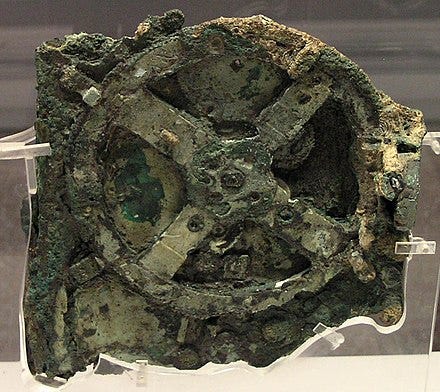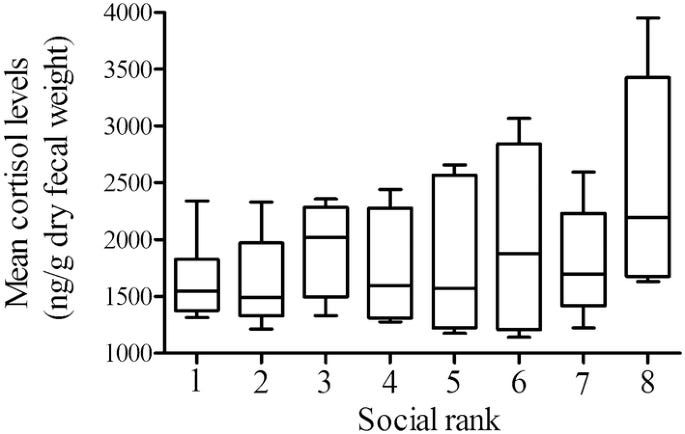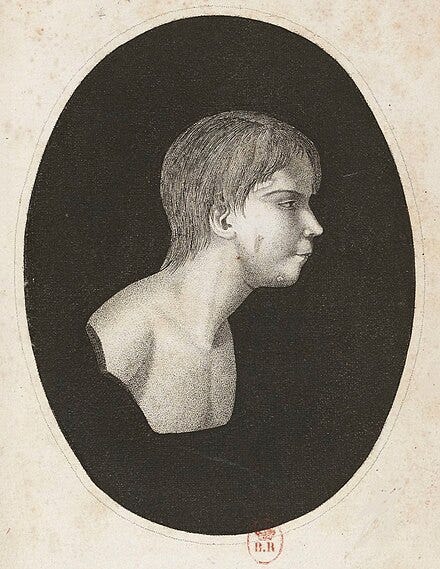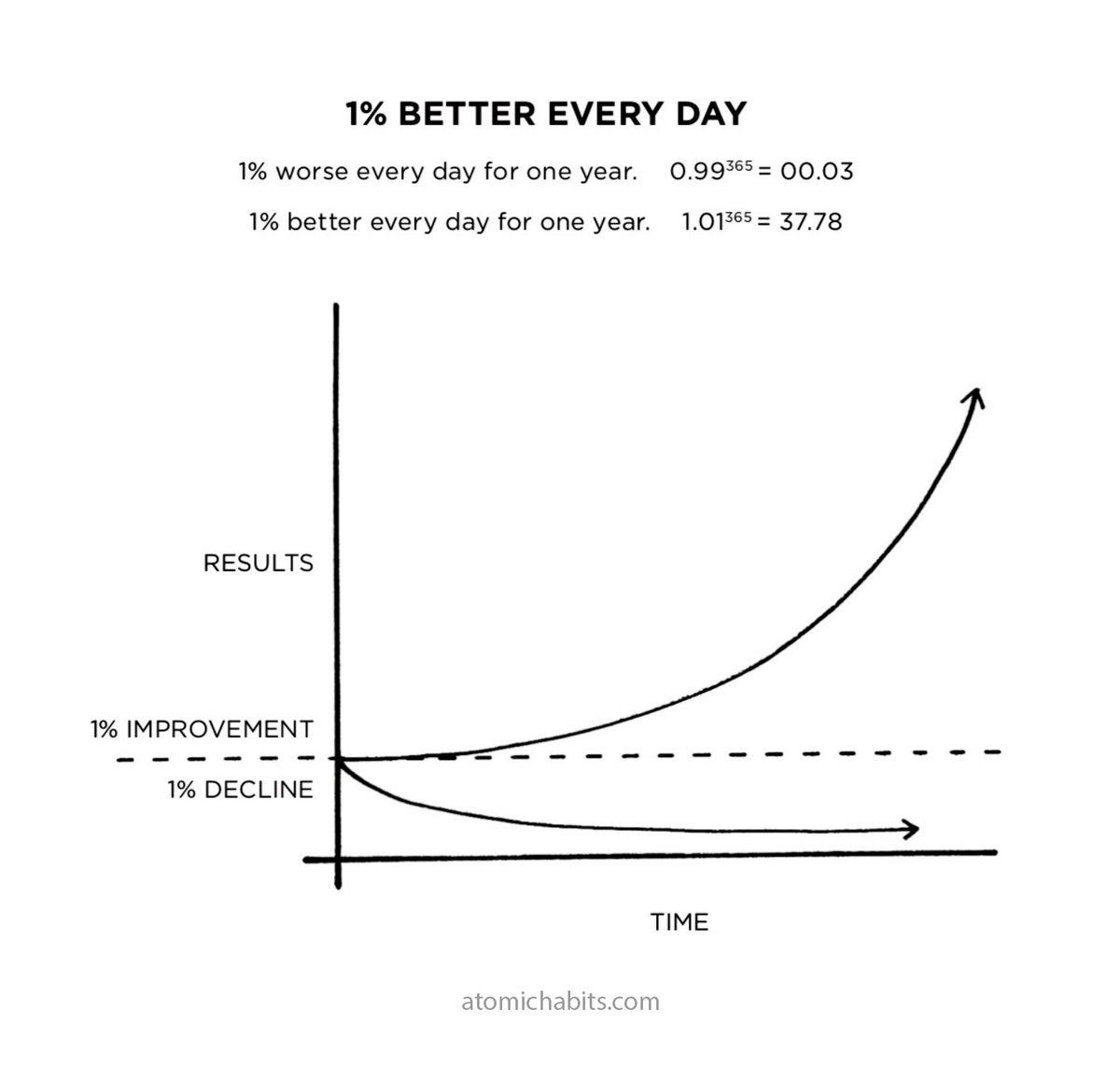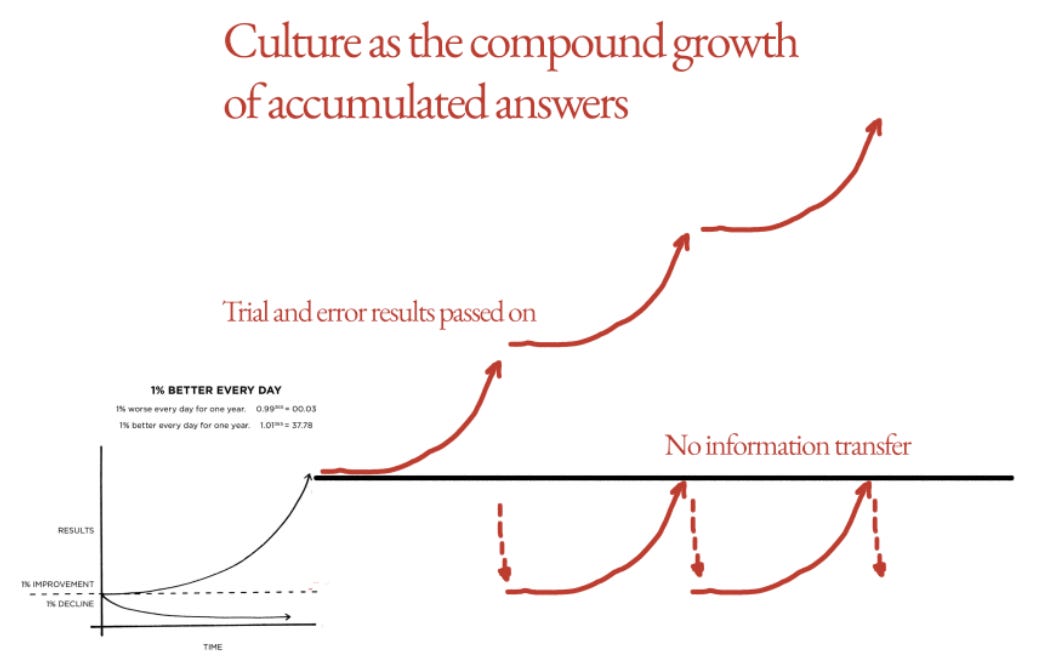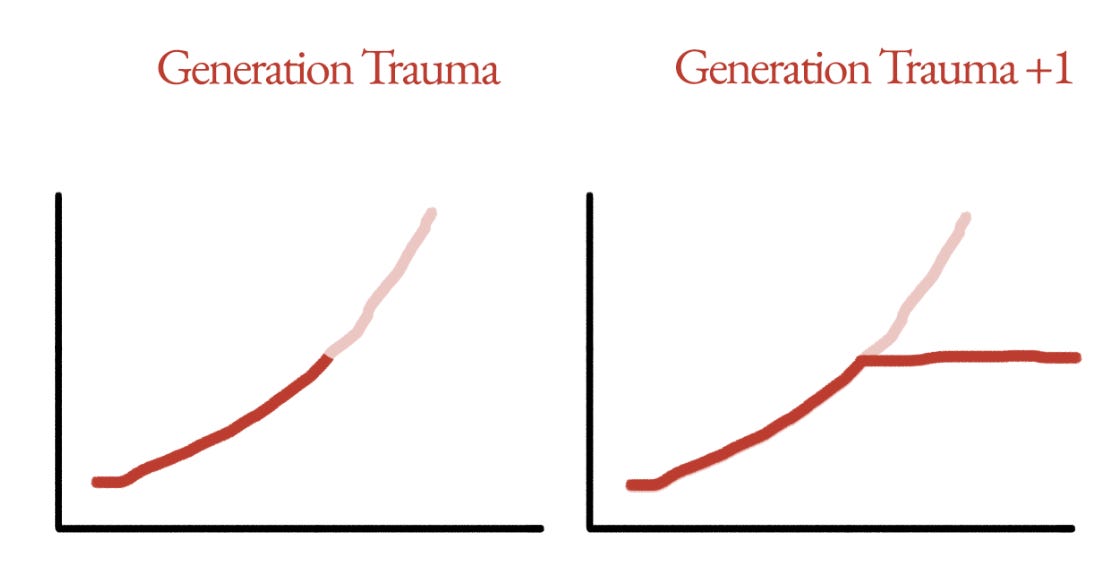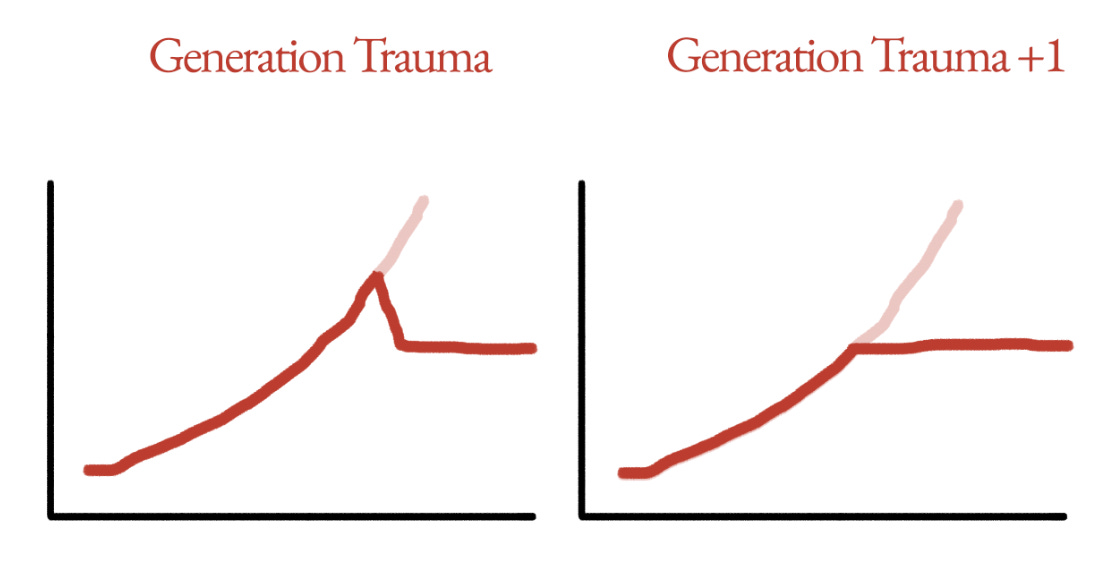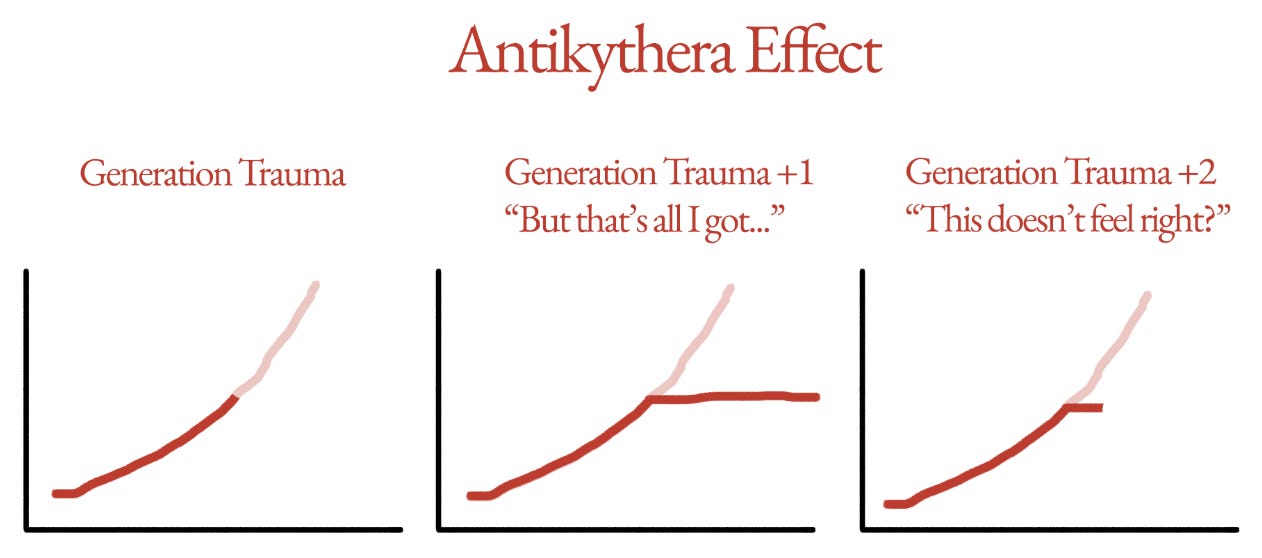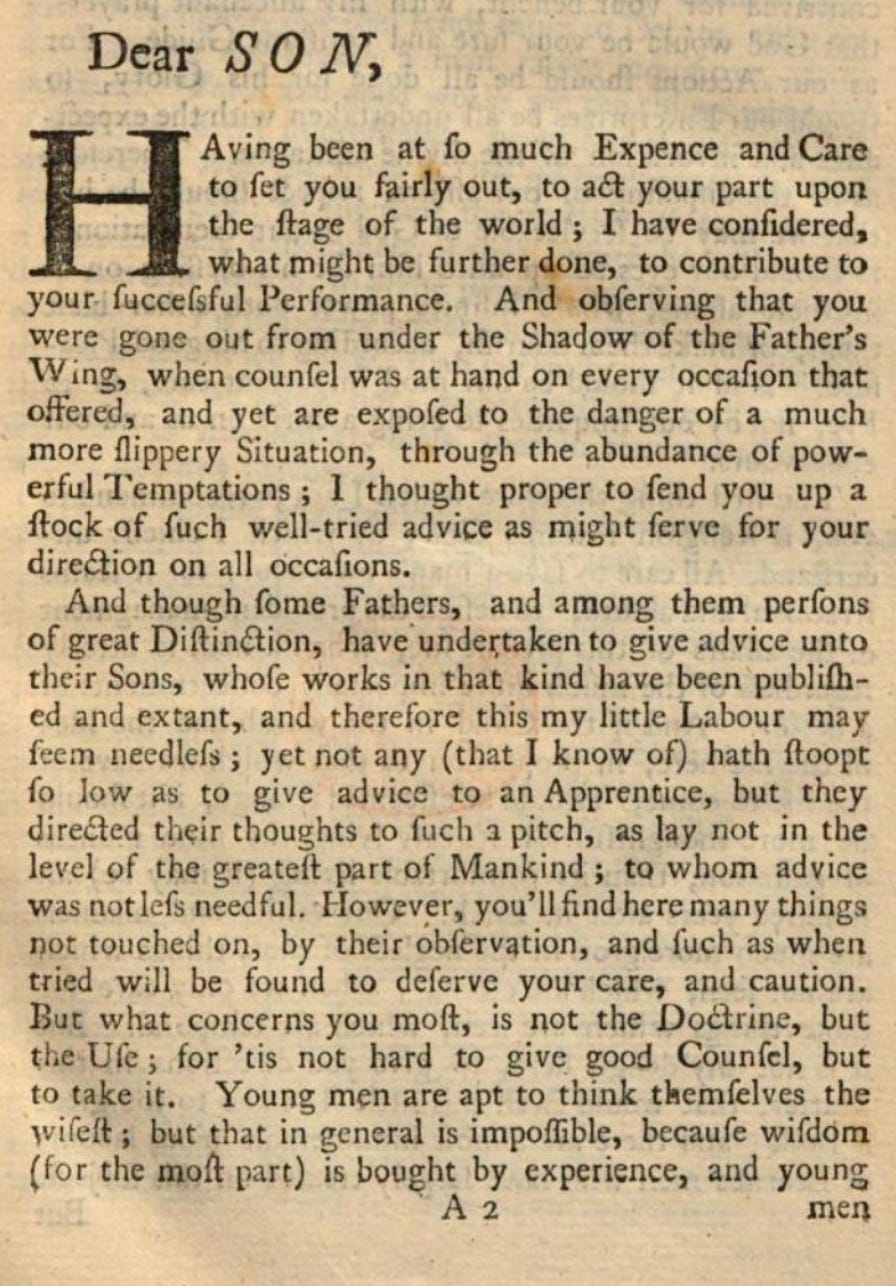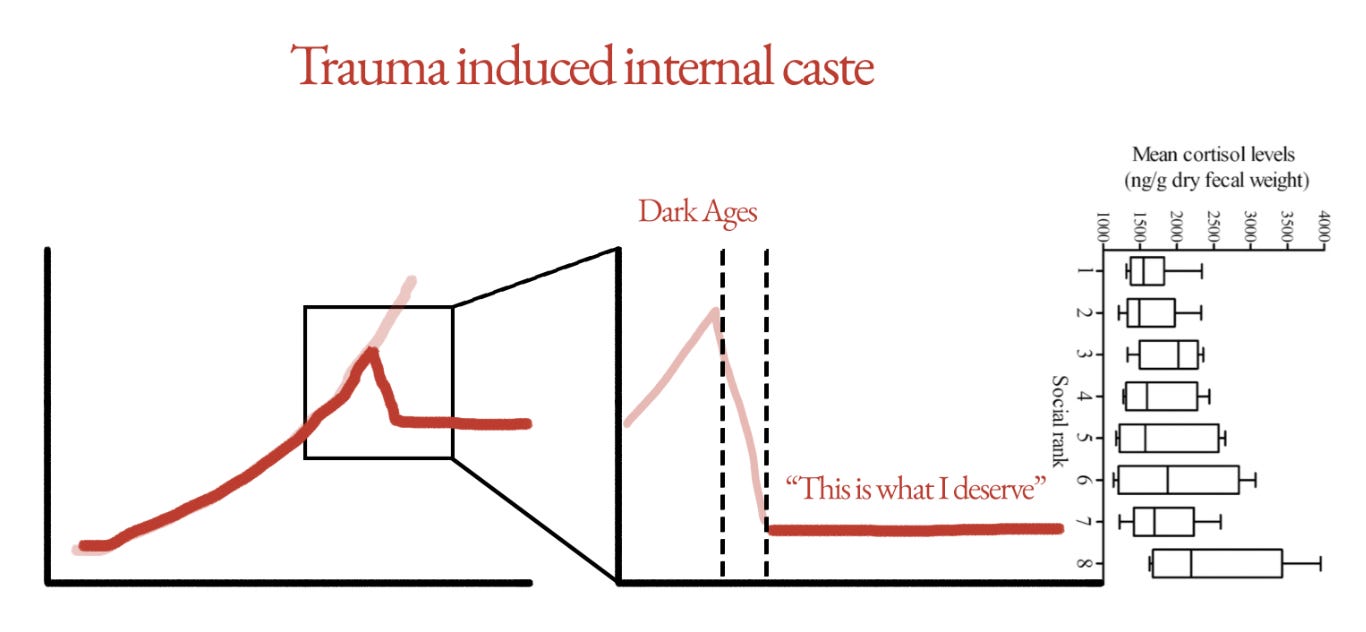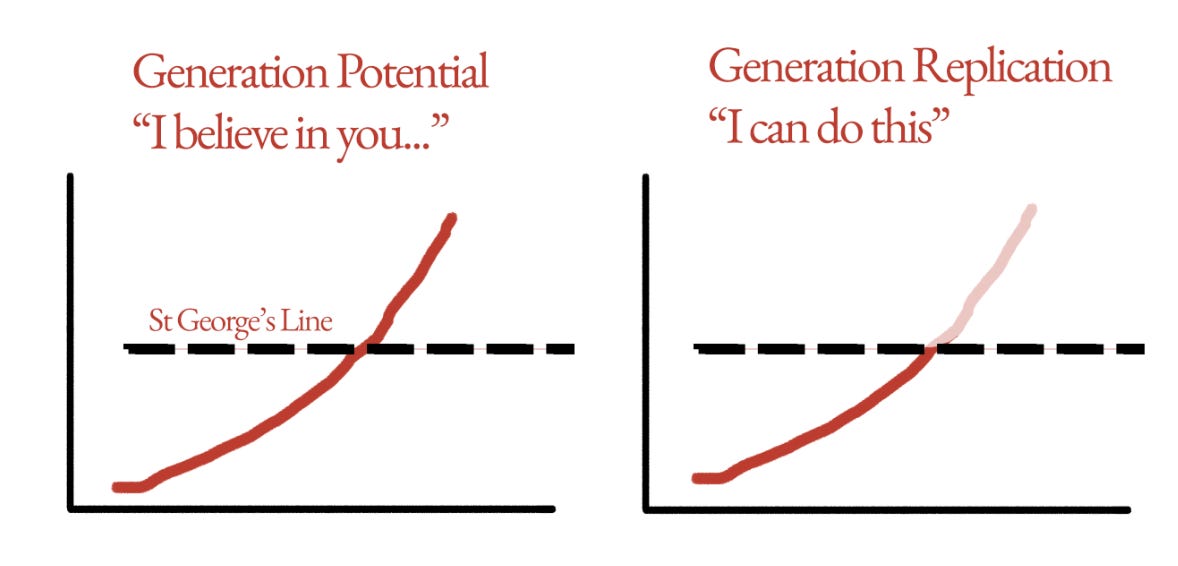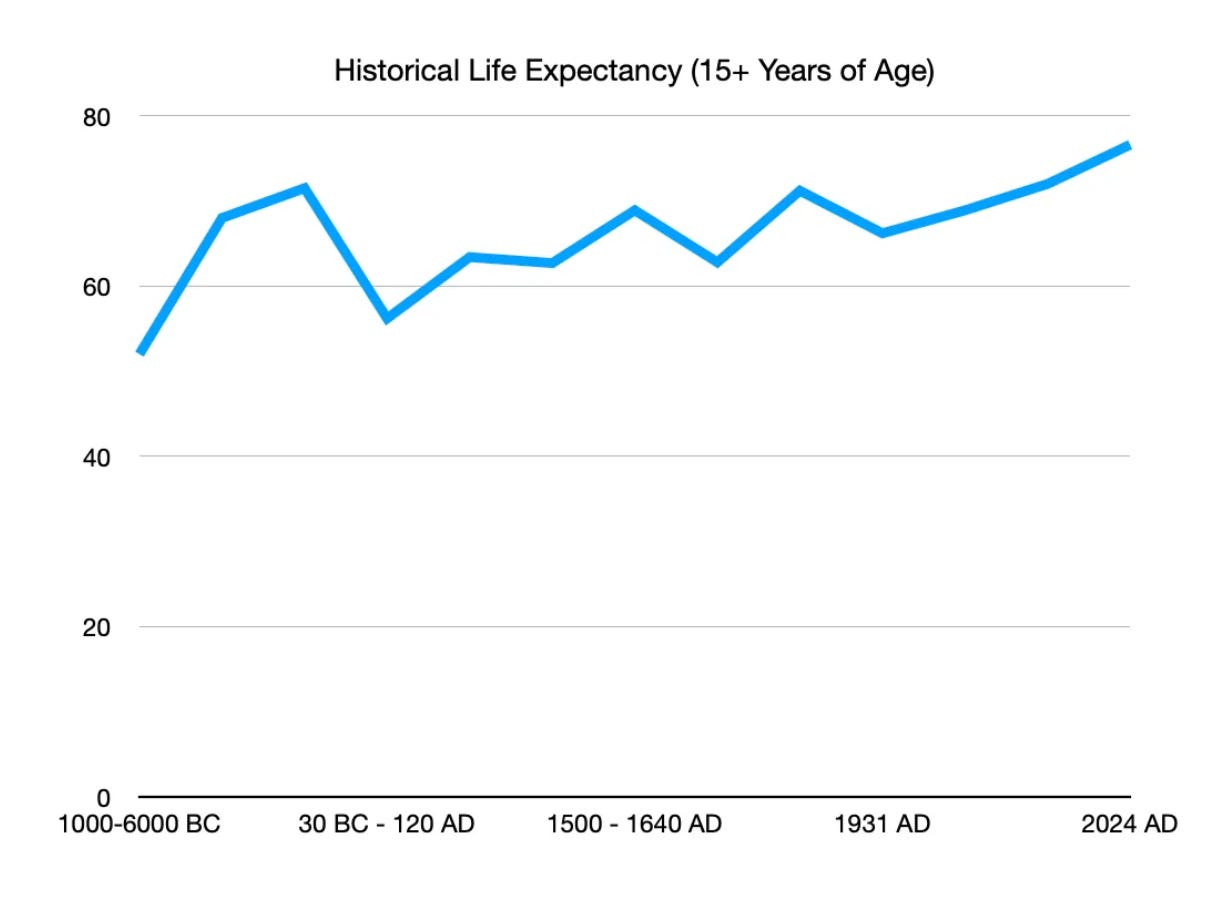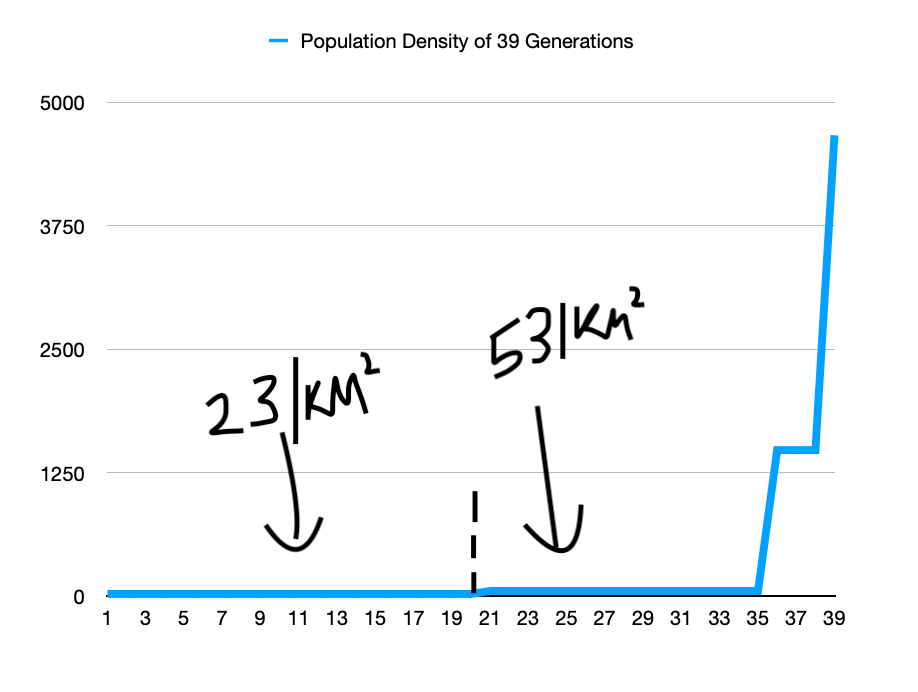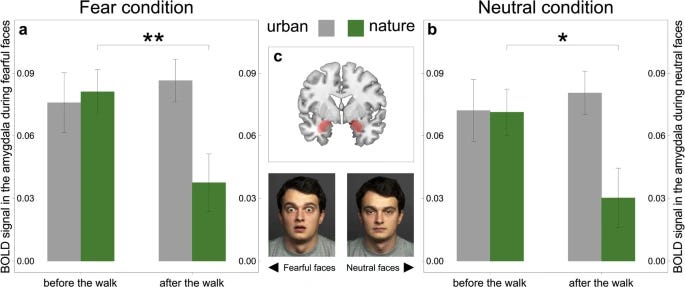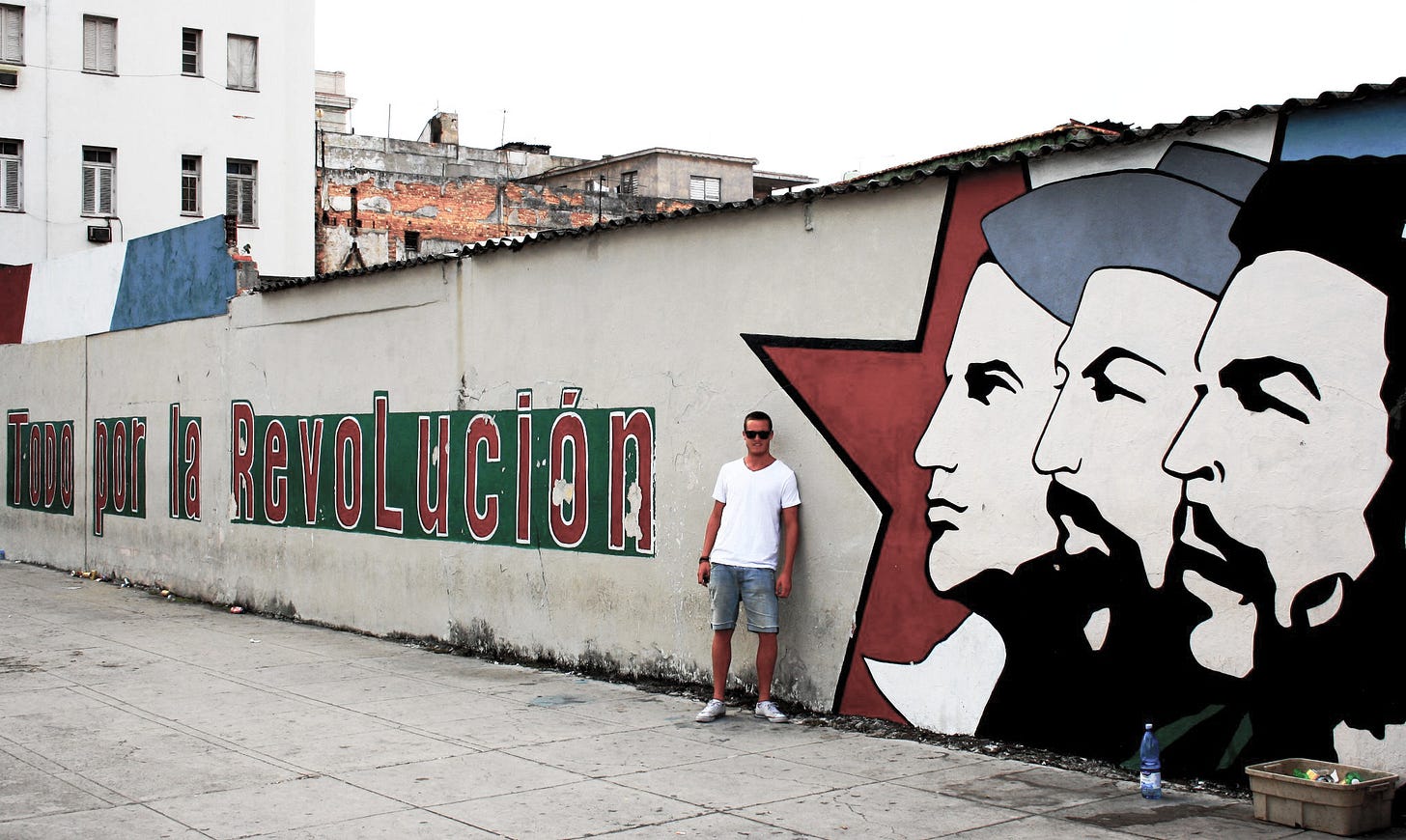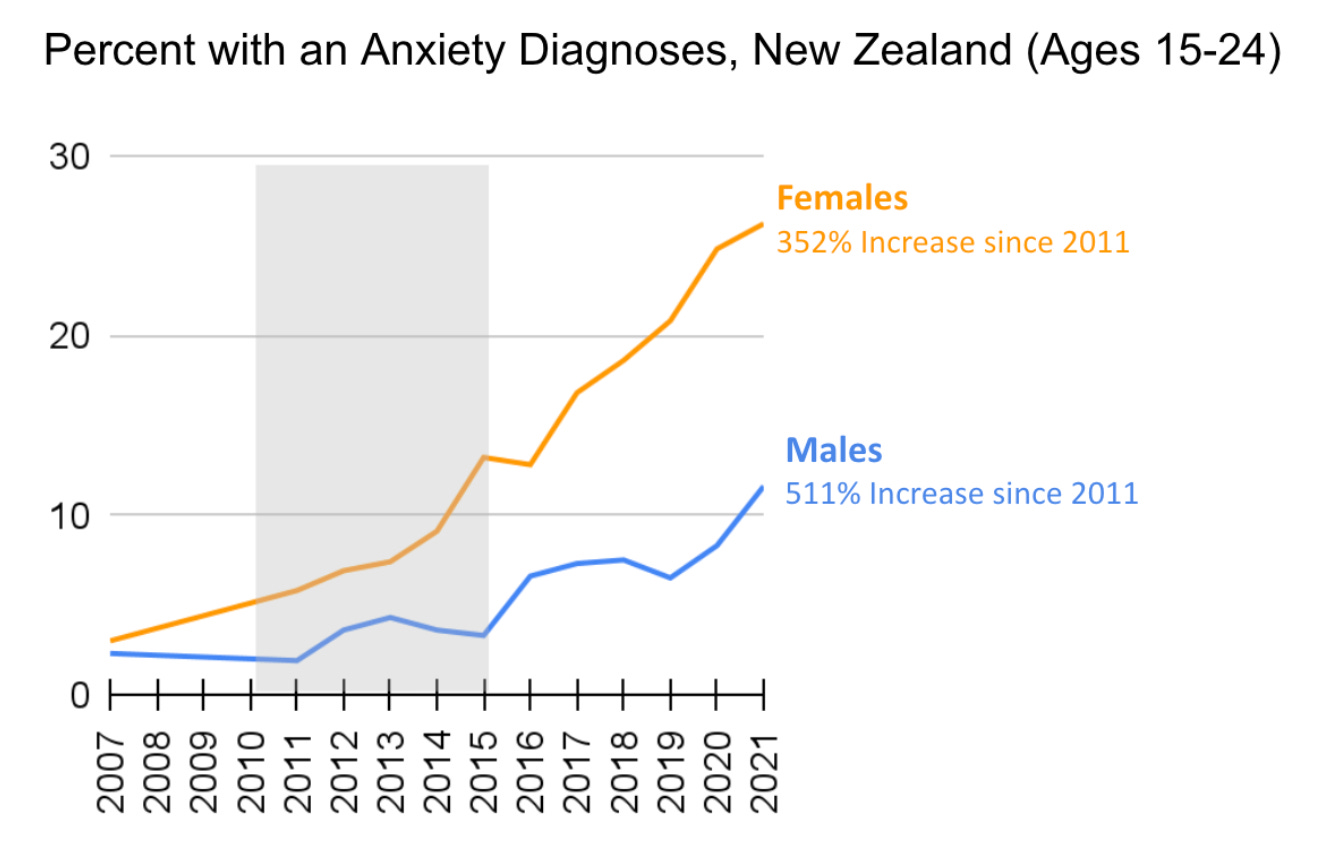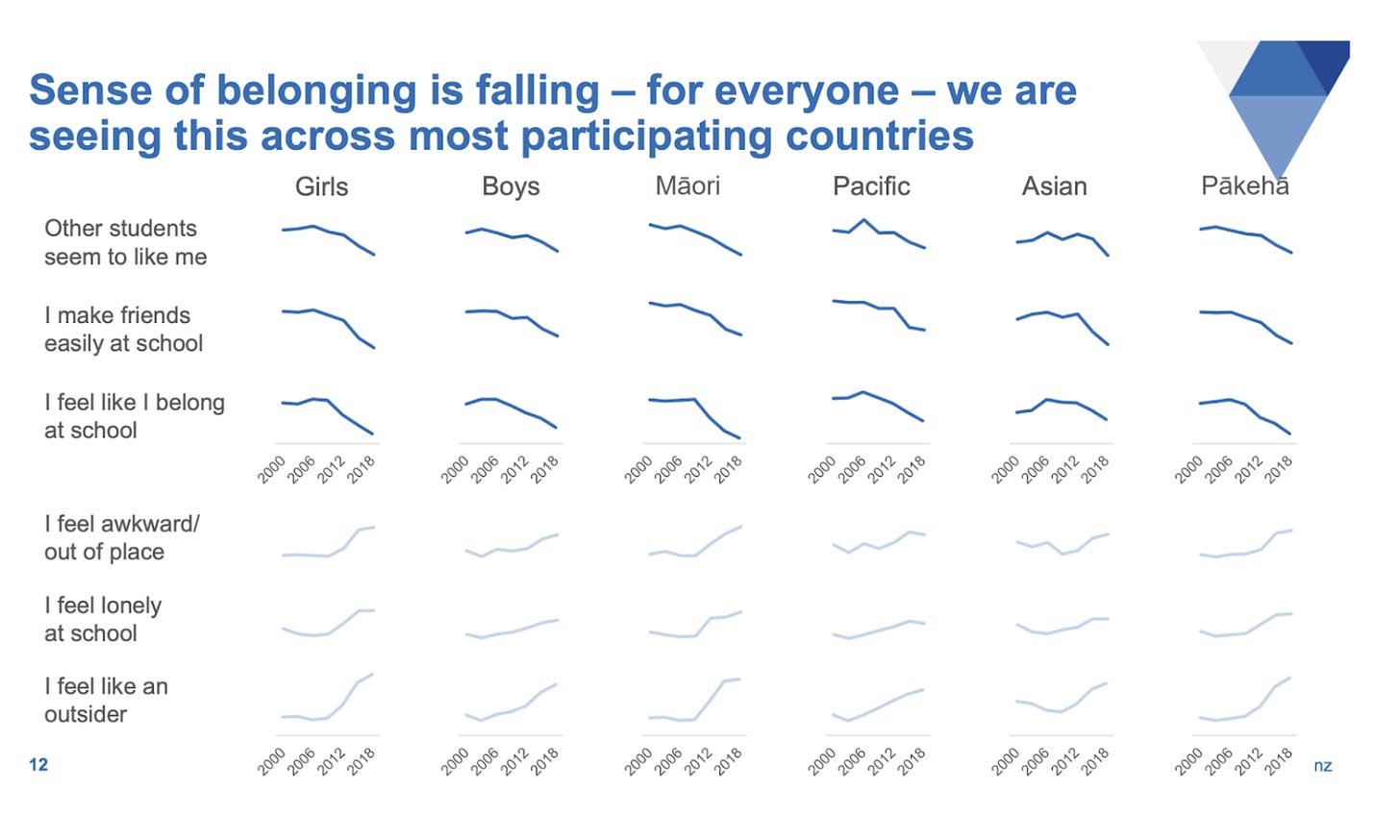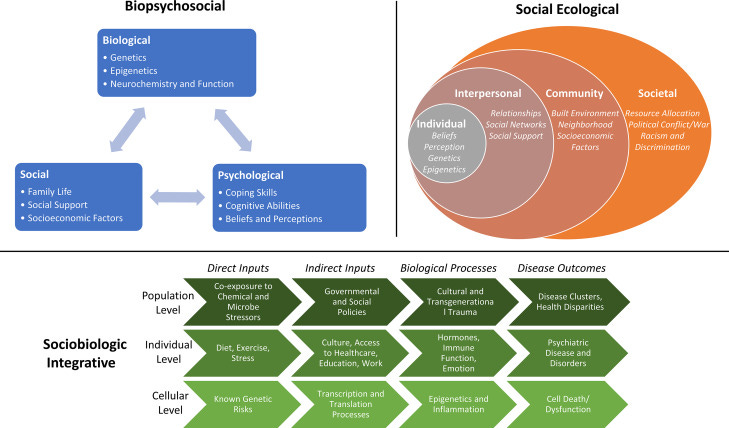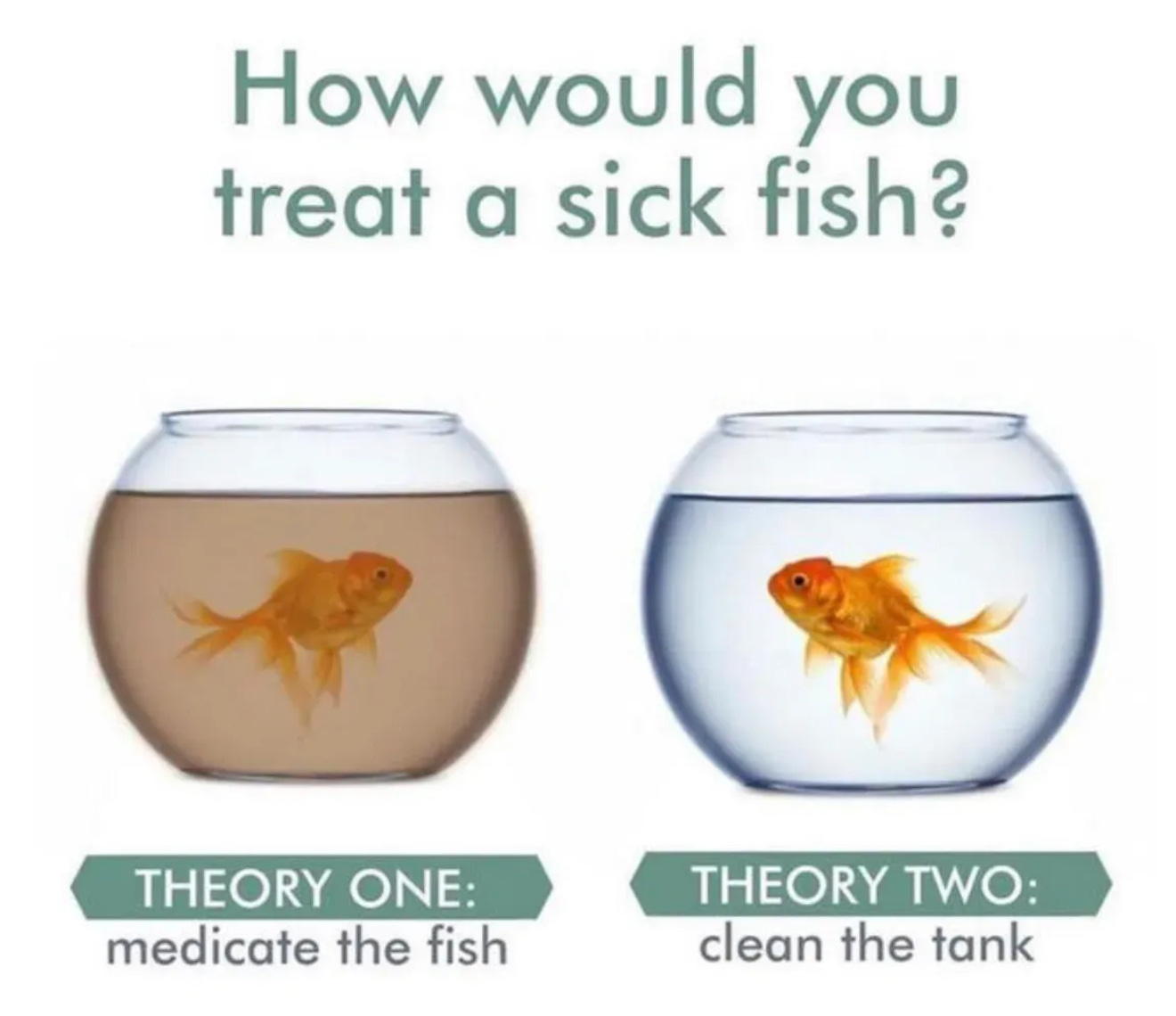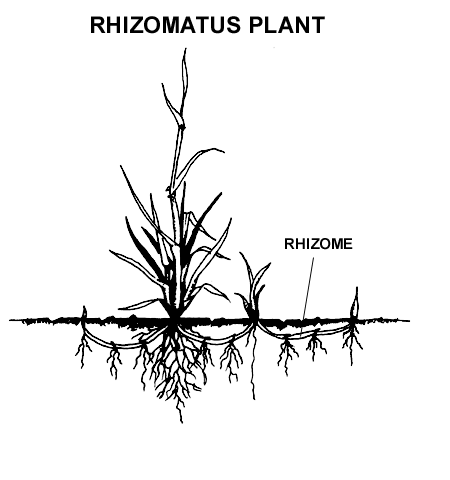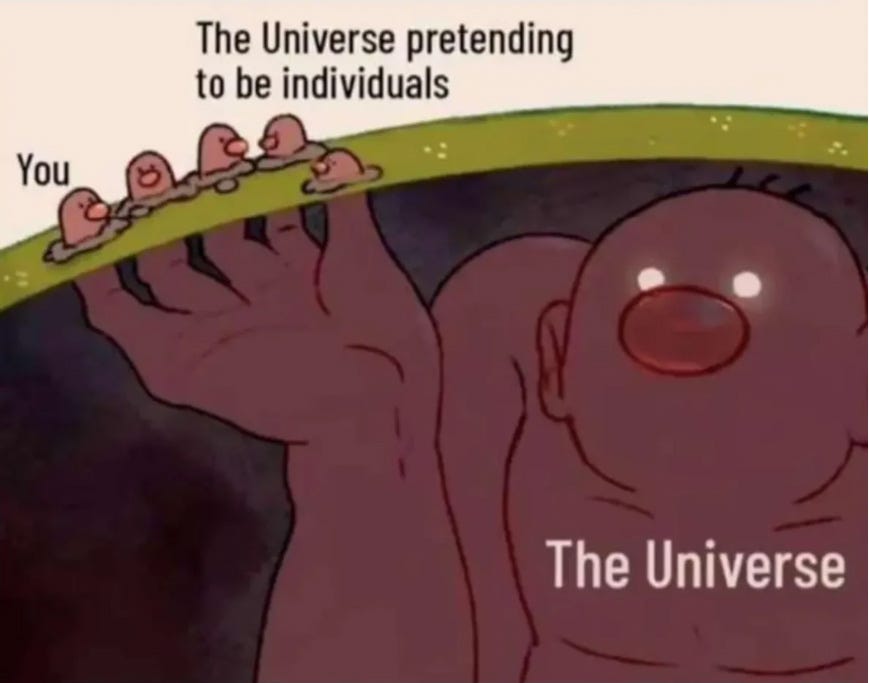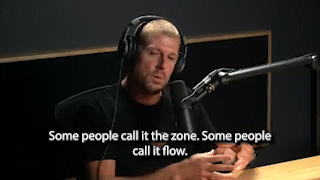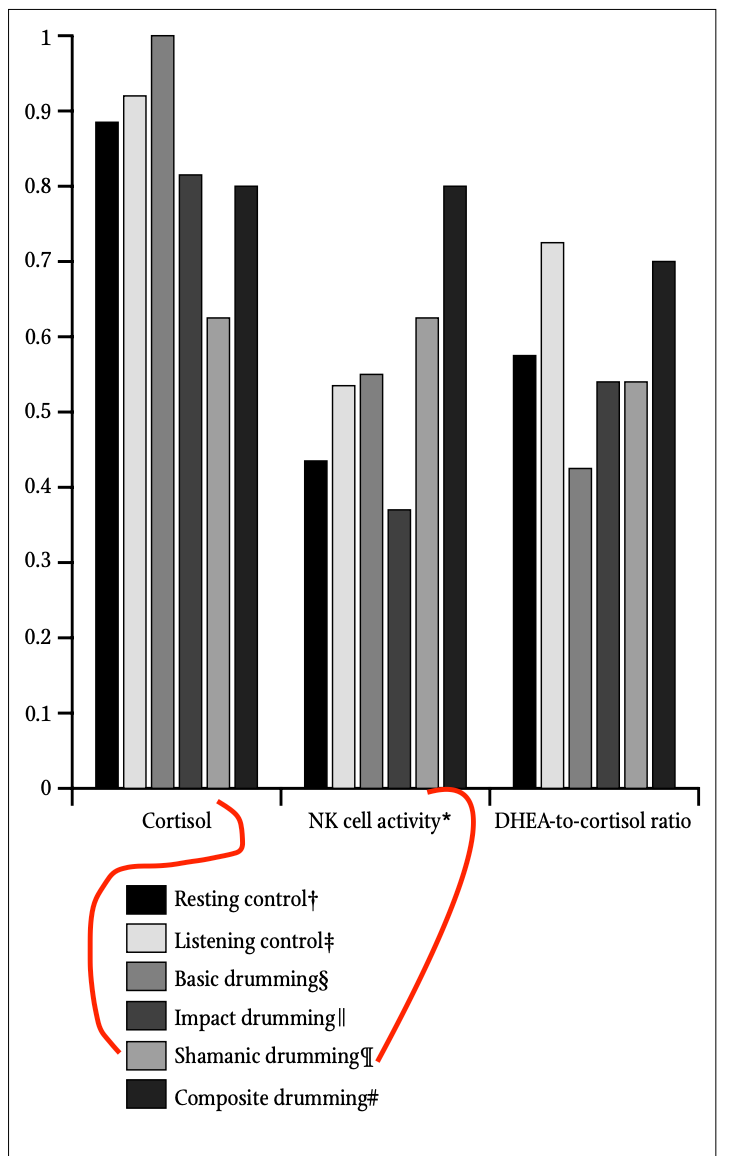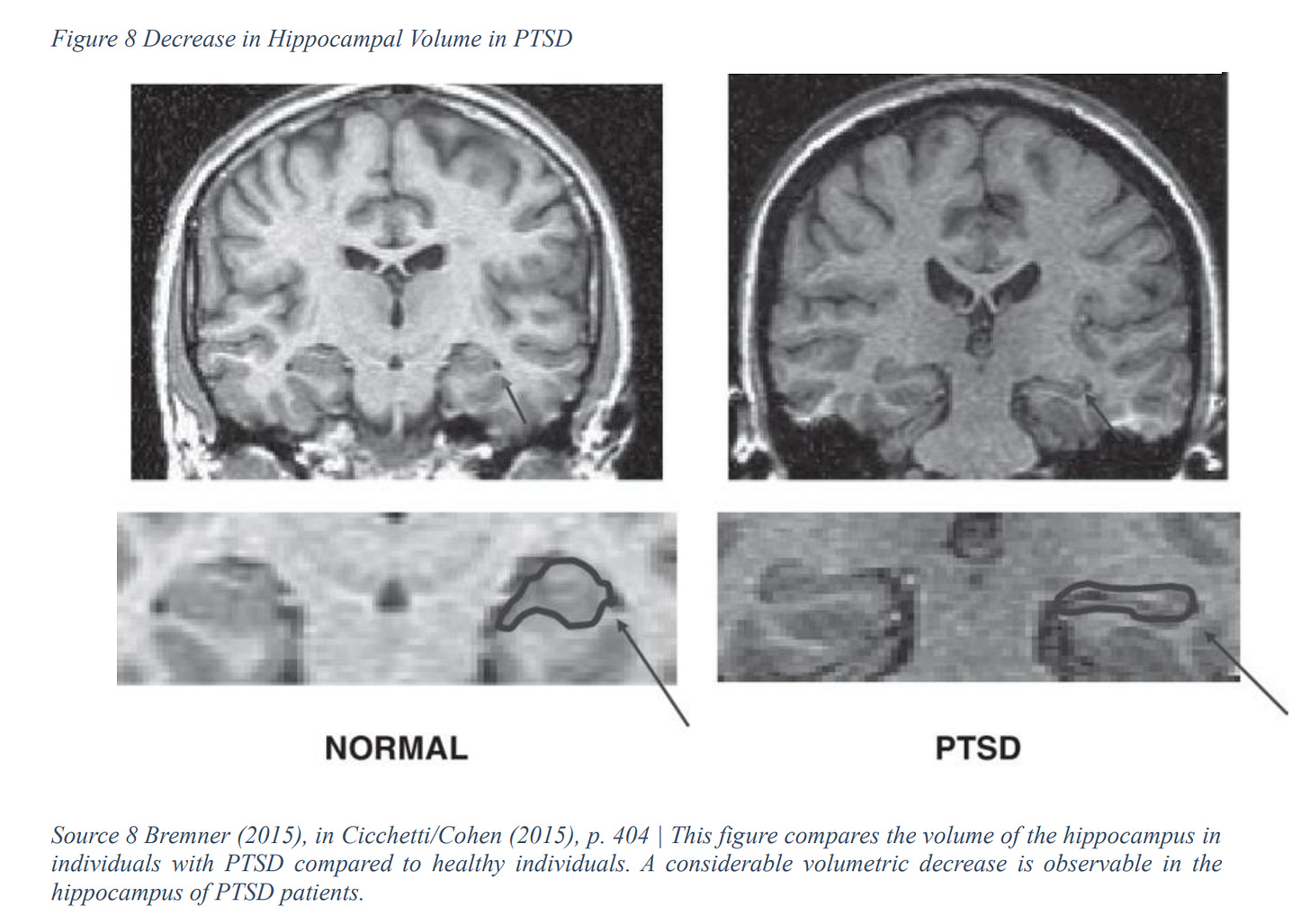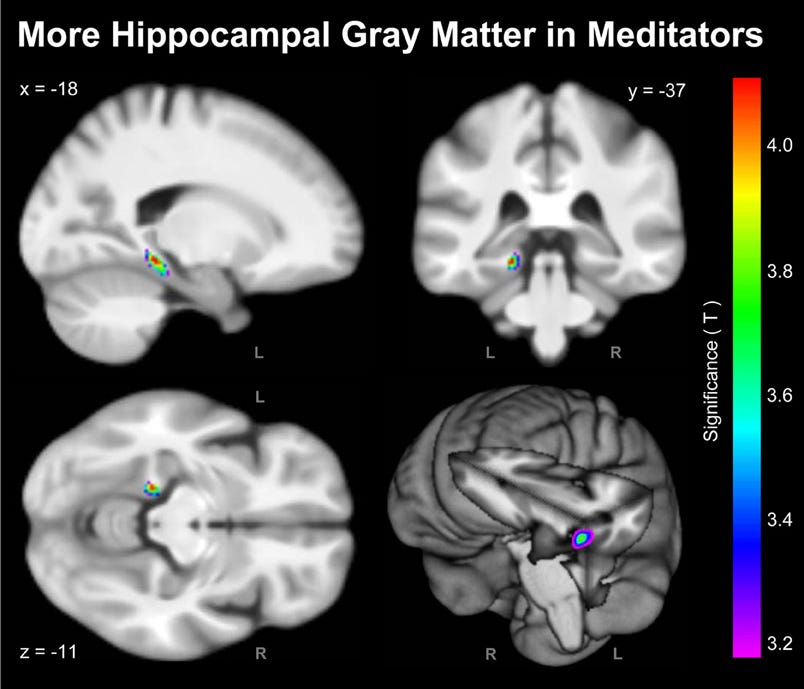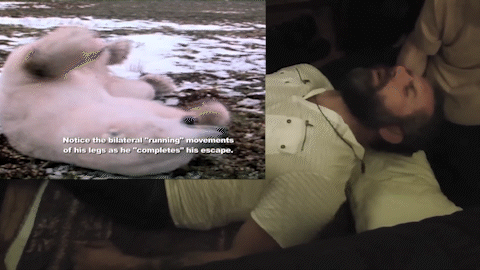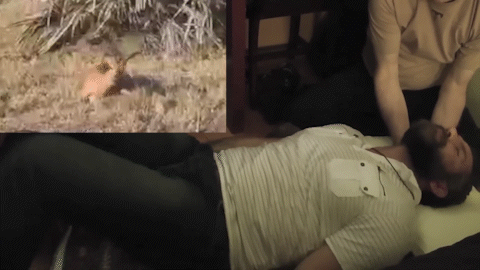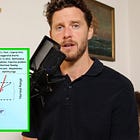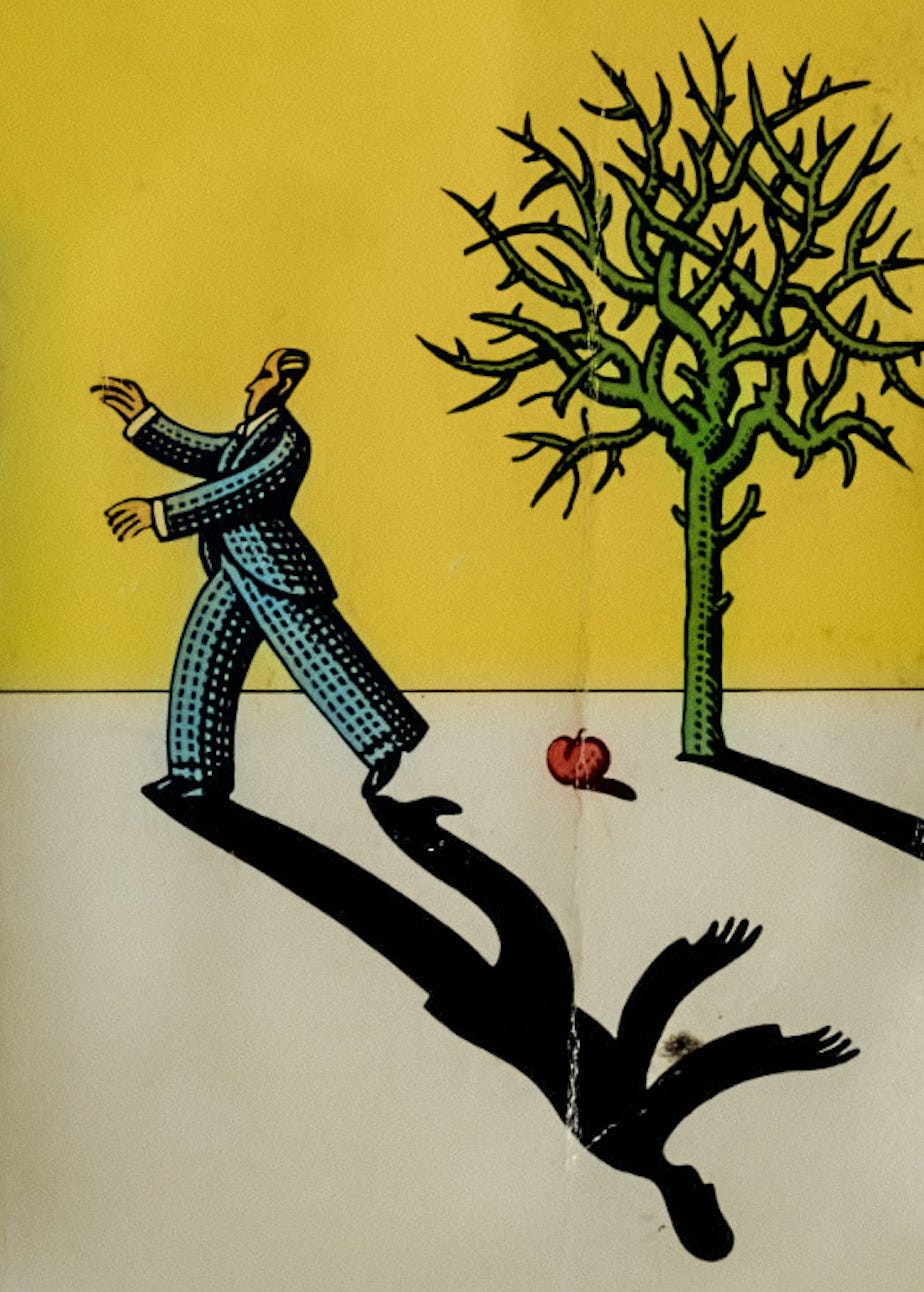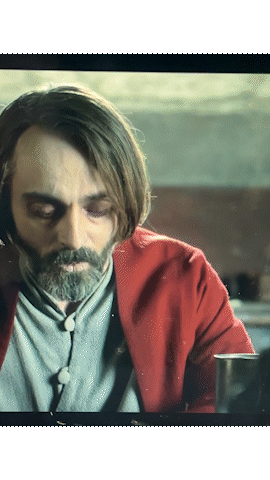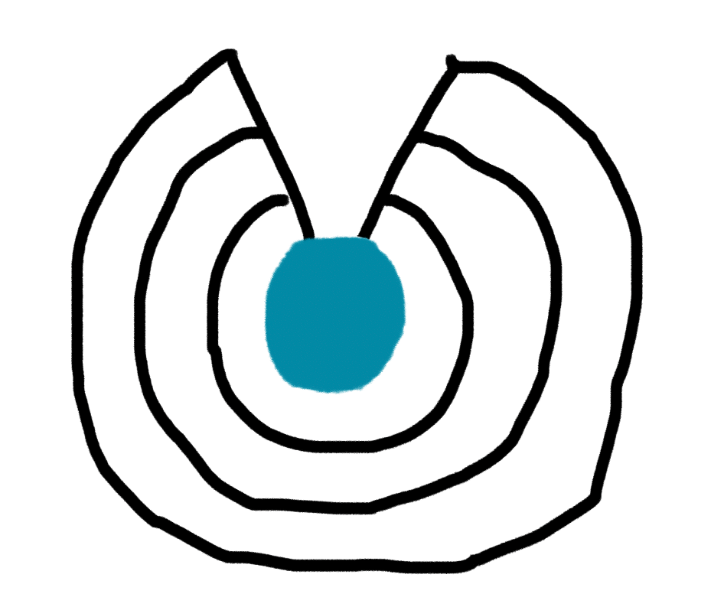“Trauma is not what happens to us. But what we hold inside in the absence of an empathetic witness.” - Dr Peter Levine
In the spring of 1900, Captain Dimitrios Kontos and his crew of sponge divers from Symi Island, Greece, discovered a shipwreck that would change the course of history. In this case, it was not a forward course, such as the invention of the printing press or the internet, but a backward course. Captain Kontos brought up the Antikythera mechanism, the world’s first analog computer.1 It was thought to have been engineered approximately 200 BC, possibly by Posidonius,2 and used to accurately predict astronomical cycles decades in advance. As investigations into the nature of the object continued, it became obvious that this mechanism was “technically more complex than any known device for at least a millennium afterwards.”34
I mention this today, to recall our human tendency to assume an ever-increasing technological trajectory afforded to us simply by taking a breath that marks a greater distance from our ancestors. We are capable of wearing blinders and believing that to look back (or even side to side) is to lose precious time.
This mechanism illustrates that not only might that not be the case, but the gap in expertise can persist across many lifetimes before, at great effort without any guarantees, we land back where we already were.
The question then begs, what else has been lost? What other questions have we solved and long forgotten? The words of British physicist Brian Cox explain this complexity:
“Information is not destroyed, it is scrambled in a way you can not re-construct.”5
One can argue that information preservation, which includes our continued ability to comprehend that information, celebrate in order to retain relevance and apply it to achieve the desired outcome - has historically been the sacred role of Teacher. Unravelling the potential that sits within us, hidden by our human amnesia6 brought about through birth.
Children deprived of a human upbringing are a shocking case of just how non-negotiable the nurture side of our human raising is for our subsequent development. These so-called ‘Feral Children’7 are often adopted by wild animals and even pick up their attributes such as walking on all fours, barking and sniffing food before eating - even after being rescued.
On the one hand, our malleability in being able to substitute species for the gift of a group is something to commend. On the other, our ‘human-ness,’ as we frequently take both for granted and great pride in, has been revealed as a fragile elevation at best, and not our pre-destined and absent effort fate.
This downward settling to monkey, wolf or bear is likely driven not by attraction but by relativity. It is believed that the same amount of cortisol is released from loneliness as being punched in the face by a stranger.8 That is to suggest, in the eyes of our complex nervous system, that social isolation is on par with physical violence as to our probability of survival.
Our nervous system, pulling from the nature side of our experience, propels us towards others (seemingly an array of ‘others’) via this action hormone, knowing full well that our chances of solitary survival fighting Darwin’s war9 are minute.
Even the risk of tribal detachment, void of the isolation itself, stirs up a tremendous amount of inner disturbance. Monkey’s cortisol levels become increasingly unstable and elevated, the lower their current position on the social hierarchy.10
Arriving back at our species, infant mortality rates for those deprived of touch have been estimated at bordering on 100%. The intervention story (described in the mother gap piece linked below) with ‘Old Anna’s’ hip holding, resulted in surprising turnarounds from only human touch when medical avenues had been exhausted.
Even if we do survive isolation, at what state are we awarded as a general inertia of human development capacity?
There is evidence of a stored intellect in children self-selecting foods. A fascinating study11 observed an infant take cod liver oil (high in vitamin D) for the duration of being afflicted by rickets (caused by prolonged vitamin D deficiency), unprompted, and ceasing to be drawn towards the remedy again once health was restored.
Non-instructed self-preservation tactics of children must be balanced against evidence such as Victor of Aveyron a ‘Feral Child,’ raised neither by humans nor adopted by animals.
The French, during this time of Enlightenment, began wondering as you may well be today, what happens when caregiving (or Teacher) is removed? Do we live as “man in a pure state of nature”12 a type of noble savagery ignorant of ill? or do we regress, in the words of Nancy Yousef, “It is one thing to say that the man of nature is not yet fully human, it is quite another thing to say that the man of nature cannot become fully human.”13
Victor, despite being re-introduced to society, cared for and provided education “made no substantial progress beyond his initial condition.”14
What starts to unravel is the development into Homo-sapiens, distinct from a type of Homo-Ferus, appears to be supported upon the shoulders of our Teachers, including but not confined to our original attachment with our parents.
This passing down of knowledge and slow off-ramp into independence is illustrated by a 28-year-long study,15 with over 10,000 variables, revealing that the likelihood of not completing high school was able to be substantially predicted (77% accuracy) by 3.5 years old based solely on quality of care. A slightly lower level of accuracy (74%) could achieve the same prediction of academic completion based on parental involvement in the sixth grade. Notably, IQ or test achievement was not seen as a statistically significant factor. That is, it was not the child’s ability to complete what was asked of them, it was their relationship with that completion, determined through support, or lack thereof, by their parents.
The author of the study stated in a subsequent paper that “nothing can be assessed in infancy that is more important”16 than their attachment to their caregivers. Other studies have shown insecure infant attachment:
Increases the activity of the amygdala, the fear centre of the brain. When dysregulated, the amygdala deems more stimuli as threatening and ushers in a subsequent energetic (exhausting) response from the nervous system to meet that identified threat, real or imagined.
Increases the likelihood of insecure romantic partner attachment at ages 26-30, the authors stating that “romantic representations appear to have some distinctive origins in earlier development.”17
Jeopardises our ability to sustainably garner social support with our peers,18 a buffering that when achieved, has the effect of dampening the HPA axis response (fight or flight)19 in the face of life’s stressors. This provides added context to our cortisol-induced escape from isolation by the Feral Child into wild adoption.
A pattern subsequently emerges that ricochets across time. Born into care not of our choosing, non-negotiable all the same, and reflecting the level of success of that attachment to peers and partners years later. These results often lapped unto the individual as their character, but in this light, logically stem from beginnings that laid probabilistic paths.
As free will seemingly fades, we start to wonder, has it all been written? We can remind ourselves here that wild-adoption is a self-healing response also applied within our village to aunties, uncles and other role models. A 16-year-old, future Queen of England, Jane Grey speaks of the delight in escaping her parental pressures:
“For when I am in presence either of father or mother, whether I speak, keep silence, sit stand, or go, eat, drink, be merry and sad, be sewing, playing, dancing, or doing something else, I must do it, as it were, in such weight, measure, and number, even so perfectly as God made the world, or else I am so sharply taunted, so cruelly threatened…that I think myself in hell till time come that I must go to Mr Elmer [Bishop of London, John Aylmer], who teacheth me so gently, so pleasantly, with such fair allurements to learning, that I think all the time nothing whilst I am with him.”20
It doesn’t take much to relate to that impulse, whether it is a 16th-century royal court or 21st-century suburban adolescent bedroom. What is hard to relate to, though, and worthwhile adding, is that 16-year-old Jane relayed these feelings after being interrupted whilst reading Plato, in Greek. One of the five languages she studied. A reminder that even with a battery-packed black mirror in our pocket, assuming our faculties are far more superior than our predecessors due to a different millennium is less than assured.
Moving on. What this diversified human making represents is a lower bound that extends much further into not only stepping in for an hour of tutoring but the amassed agreed-upon practices picked up in work such as the dual-inheritance theory.21 This theory posits that “two structurally different inheritance systems,” genetic evolution and cultural evolution, aid our transmission of the determinants of our behaviour.22
Rather than simply new-born to parent (or foster parent) we are reminded again that no man is an island23 as we swim in a sea of influences necessary for our progression.
A large percentage of this sea has historically been caught under the umbrella of religion. Today that word can provoke a variety of responses, but in earlier times, it was rather synonymous with culture, as John Bowker describes:
“Religions are the earliest cultural systems of which we have evidence for the protection of gene-replication and the nurture of children.”2425
At an extremely basic level, we can simply say that a question arises as we interact with the world, we make an attempt at answering that question, we make an attempt at holding onto that answer during our lifetime, we make an attempt at using that answer to direct our behaviour, we make an attempt to pass that on to those of the next lifetime. The accumulated attempts and broader cross-verification for replication become an agreed-upon way for a certain group of people, to meet the demands of life. The label of that process is an afterthought.
As that accumulation builds, we save a lot of time by not re-testing every berry and mushroom for its effect outside of nutrition. We note down the ones that took our loved ones through toxicity, and the ones that make us see dancing demons.26
This provides a compound interest that can be illustrated by the ‘1% better everyday’ concept cheered on by James Clear’s best-selling Atomic Habits.27
Placed within a cross-generational context, as below with great simplification, a lack of successful information transmission creates a groundhog-day glass ceiling. We are born, encounter the same tests as those that came before, and trial and error our way through. Culture and the human teachers that apply it give us the gift of a starting point of another’s lifetime. Or in the words of Sir John Barnard, writing to his son in the 1700s on the importance of this information transmission:
“You may be wise, as if you had already lived more years in the World.”28
There are countless caveats that poke through the novelty of the above drawing, but at its core is a reminder of a choice between playing repetitive Russian roulette with our interactions with the world or slowly emptying the chamber of non-essential (given our new data) threats, freeing up our attention for other useful pursuits.
Answers such as how to mark the milestone of birth, the rite of passage of adolescence, the confirmation of union between two people, the celebration of a life that has met death, what is right, what is wrong, and what to do when we do wrong.
The shared association with a commitment to the solutions presented to those questions galvanises a group of people to mutually support each other through the trials of life.
The trouble is the transmission of that information (individually and collectively) can be interrupted, even with the best intent. This cultural inheritance, no matter how valuable we find it, is susceptible.
On the morning of September 15, 1916, Private Frederick Field of the Bedfordshire Regiment, 8th Battalion sat patiently in position, readying for a dawn attack on enemy lines. It was 4:20 am, and the two-hour wait for zero hour must have felt like a lifetime.
The battalion had been on the Western Front since August of the previous year, but this day stood out amongst others. It would be the first day in human history that a tank was to go into battle.29 Human ingenuity created a machine that could plough through barbed wire, cross trenches and be largely inpenetrable to rifle and machine gun fire.
At 6 am, heavy shelling began, and by 6:20 am, it was time for infantry to advance along with these man-made machines of war. It was hoped they could be the difference that finally brought an end to one of the deadliest conflicts on record.
A combination of blunders ensued. Only 18 of the 32 tanks30 that arrived could advance, the rest suffering mechanical issues or becoming stuck in shell holes. The artillery fell short, and Frederick with his brothers in arms, had to resort to a battle strategy as old as time itself. They advanced on foot, and did so highly exposed.
Frederick fell that morning with his face towards the foe. Never to return home to his loving wife and the embrace of his three children. Never to coach his cricket team at the local sports oval. Never to order another round of drinks with his mates at The Grapes, his grandfather’s pub, a short walk up the road from the family home. He served his country and his family and paid the highest price.
The abrupt breaking of information transmission, which we have highlighted the immense value of, is clear to see under this type of circumstance. Instead of the scaffolding of a reliable ear, shoulder and source of advice for life’s trials - we mourn the vacant seat we wished they still occupied.
We are vulnerable to this loss from more than just one-off traumatic events that cut short a lifetime.
Sarah Thompson wrote a letter to the Australian government on the 8th of May 1917, asking for an update on her son. Six weeks had passed since hearing of the severe gunshot wound he received about 30km east of where Frederick was killed months prior.31
When we talk about the frustration of sitting in uncertainty today, we can joke about an upcoming Netflix series we are excited to watch but remains unreleased or an Amazon delivery that would please us if arrived even earlier. Awaiting written telegrams from the other side of the world to update you on the life or death status of your child, must have been an entirely different distress.
Reginald, however, was only one of her offspring. Another son and six grandsons would later serve in World War II. This time, instead of France it was on Sarah’s doorstep in the Pacific. Two would never return. Keith lay today in Papua New Guinea, whilst Ronald is buried in Borneo. Sarah was my great-great-grandmother.
Under this circumstance, we may see the trauma generation experience as something instead of an abrupt ending, a persistent strain on our nervous system, that calls for all available resources in an attempt to regain homeostasis.
Even with the best care, and all the knowledge in the world of how to interact with what life brings, if there is no water in the well, our human vessel runs dry. No library can help us outthink that.
The next generation, in receiving what was possible to be given during scarcity, is capped at the newly reverted level of Teacher qualification. This may be in the form of skillsets, levels of attention or even the reliance on role reversal for a younger generation to fill an elder’s shoes due to low capacity.
The generation there afterwards (generation trauma +2), with the threat fading from familial memory, begins to ask if there are a few missing pieces. A stirring up inside, sometimes indescribable, but undeniable, places pressure from below to take us back up to where we once were. An ill-equipped moment, a request for an outstretched hand, or a refusal to succumb to role reversal in abundant times.
At this point, the child of suffering, looks upon the child of abundance and says, “How can you ask for more than I was given?” We might like to start calling this the Antikythera Effect. A misplaced knowledge, oftentimes unknown to be lost at all.
No different to the generations of the Dark Ages, oblivious to the technological advancements of the Greeks that preceded them. How can we be asked to show what we don’t know?
One generation’s scarcity becomes the next generation’s new baseline, and as the original threat fades, this baseline of what was received is how we measure what we shall give. It is our definition of roles and responsibilities of caregiving, based on our exposure of being on the receiving end of it.
War, famine and economic depressions are the most readily available societal examples of this. In individual cases it may be the rise and fall of love, business ventures gone bust or abuse. We can no doubt all think of a story that would apply.
This altered definition of the role of Teacher, may be seen poignantly by our father and son correspondence of the aforementioned Sir John Barnard.32
A cursory read, reveals a time very different to our own. A father who makes abundantly clear the investment that has already been outlaid but connects that immediately with the expectations of fairness of its receipt. And after that, ponders, what more can he do? Even when counsel was offered on every occasion, with this world of temptations, perhaps a little extra advice would keep his son safe.
This representation of the scaffolding obligation of a father stands in contrast to many of our experiences. The modern man has a propensity to work as a symbolic gesture of love. Long hours, ensuring the bills are paid, with the goal of their children to want for nothing. Evolutionarily speaking, this stems from a similar pulse as our Sir John.
Men’s oxytocin, uniquely increases substantially after effort, rather than simply presence. The more effort he puts in, the better he feels connected to his family on return.33 His less obvious requirement after the moment of conception is met with proof of his worth.
The difference is that when this software was embedded in our biology, that work was in the village, often in the presence of children as they observe the necessary skillsets one day they will have to employ. Today, it happens in exclusion.
We have yet to fully reconcile this lost village connection contradiction.
A child’s primitive desire for acceptance, a non-negotiable in order to maintain its safety given it can not feed, clothe and shelter itself, is weighed up in their mind by a father’s presence, and for the case of their mother, her empathetic understanding.34
We noted how the changing village has drawn Dad away, and so too has it impacted Mum. The increase, out of necessity, of dual-income households has resulted in a significant rise in outsourced childcare. This has the ability to increase a child’s cortisol (the stress hormone) and even reverse their circadian rhythm.3536 Thus a higher baseload of stress to be regulated back to safety in the child.
With mum now also working long hours, in addition to her full-time job in child-rearing she is not only exposed to the fluctuations of home, but that of workplace too. A reduction in her buffering, particularly in social contact with other mothers, means she is also coming home with a higher baseload to be dealt with. The important and often overlooked interaction thereafter is the transferability of that.
We are born to participate in each other’s nervous system.37 For children, they don’t just interact, they are an extension of their parents nervous system. We used to talk about a child’s brain pre-seven in regards to being able to ‘top-down’ or rationally bring back homeostasis; now we understand that brain maturity continues until at least twenty years old38 (perhaps making sense of some of our teenage transgressions).
A mother or father can transport the stress they felt in an office or worksite across town, and in reality, across time, as a child absorbs scarcity signals through their parent’s odour,3940 once again activating cortisol levels. According to the child, the threat of a highly strung-out boss, irrational client and/or overbearing colleague has all just walked through the door too.
An increased demand, a decreased capacity, a widening gap.
These gaps in the provision of emotional regulation or social support, for that matter, result in a temporary suppression of authenticity in order to maintain a status quo. A minimum viable level of burden a child places upon their caregiver is uncovered, unconconsciously.
If that level has been conjured up in scarce times and projected into abundant times, the distance between security and insecurity is resolutely resolved, by the assumption of our own fault of character. They are older, they are wiser and they are less likely to be wrong than us, right? That shortfall is felt as shame and is calcified as an internalised set of disempowering beliefs.
The resulting suppression of authenticity, is not just our personal preference of ice cream topping, knowing that is disliked by mum or dad, it is the decision to not make public what we feel privately. And only in that public space can our disturbances be released by an empathetic witness.41 This is the seed of our disturbance.
This seed can be trampled by an enriched environment, an array of positive role models, and the ritualistic release of pent-up emotional energy (e.g. adrenalin and cortisol) from unpredictable or sustained periods of stress. But in the absence of that, events are transformed into trauma and life’s ups and downs into anxiety.
It is the gap we’ve revealed, that first prompted me to investigate my family history with Lincoln-esque intentions to find a reason that could be anything other than my shame. President Lincoln famously said of his opposing generals, “Don’t criticize them; they are just what we would be under similar circumstances.”42 What smoking gun would help me understand the why behind what I saw most clearly, and what seemed to be completely obscured from view by those around me?
Reluctantly, I had dragged myself into a therapist’s care with c-PTSD and a story of cyclical breakdown characterised by paralysing anxiety. This had given me pause and reason, to take a check-in, a replay of the tale of events that had the potential to bring about these endings.
Under this new mentorship, I started to understand more about how wide the distance between the care and support we deserve and what we receive played out in my own life. A reminder, this ‘deserve’ is not an opinion. You can’t raise pot plants in a cupboard under the stairs, you can’t raise humans without human care, as Victor revealed to his rescuers.
Something that came to the surface relatively early, with this newfound support, was a re-emergence of memories that were previously irretrievable surrounding the violent and sudden death of my family dog at seven years old. After the day itself many years ago, the event was never spoken of. Whilst, my emotional reaction marked by despair was met with isolation. As Dr. Gabor Maté reminds us, when conflict arises between self-expression and parental connection, evolutionarily, we have no choice, but to sacrifice our authenticity.43
This one-touch roadmap accompanied me throughout the confusion of growing up. Those around me often didn’t know the subjects I studied, the names of my friends, girlfriends or what music I liked. If that interest in my internal world was a bridge too far, a test with the trivial, coming in with a truckload of tough was certainly out of the question.
This is not weighed up, as we do at times waking up from a nightmare as a child, standing outside our parent’s bedroom wondering if this one is worthwhile seeking comfort for. The nervous system doesn’t even present the item on the menu. Memory loss, such as the suppression of a pet’s death, becomes a recipe for all unexpected demands on our nervous system.
We start to live beside ourselves in dissociated states as a track record of not working through experiences builds inside of us, increasing our level of vigilance, or ‘hyper-vigilance,’ that becomes our default mode in order to prevent further defeat. Our body has lost faith in our social stewardship, and it takes over first through a whisper of unease, and then a shout of shutdown.
As my meditation teacher reminds us to ask, ‘Where am I exhausting myself in the search for motive when locating ignorance will do?’ The Antikythera Effect, at least for me, provides some sanity to the shortfalls. However, lack of intent doesn’t excuse the outcome, and my digging had a few more insights in store.
The earliest records I unearthed in my quest for answers went quite a ways back. On the same land that my patrilineal ancestors farmed for 17 generations before coming to Australia were exchanges in the year 1220 of Robert de la Felde son of Lēofweald, Æthelwine de la Felde and Hróaldr de la Felde.
Names confirming the settlement by the Saxons in the sixth century4445 and later one one of the many frontlines against the Viking invasion.46 But we don’t see those names commonly today, and that’s because William the Conqueror arrived and received the submission of the English4748 about 10 kilometres up the road from the Field family farmhold.
Whilst by name we can assume origins and associations with events, what’s uncertain is who we were before the Normans took records. The Dark Ages, in contrast to my youthful belief of lower luminescence, was named so by a void of information, instead of the written roman traditions that has given us the innermost thoughts of Emperor Marcus Aurelius via his published Meditations,49 oral traditions took precedence.
In the absence of information, we revert to the status quo until alternative facts prove otherwise. Such alternate facts have begun to emerge. The discovery of the Sutton Hoo helmet, believed to be that of King Rædwald of East Anglia was “work of the highest quality, not only in English but in European terms."505152 This was not an unskilled people, their baseline was not necessarily up from 1066.
The reason I indulge in this journey back in time is to prod ourselves to ask, how do we value ourselves and where did this belief take hold?
The landholders adjacent to the Field family were King Harold Godwinson, his brother Leofwin Godwinson and his sister Queen Edith (wife of King Edward).53 Have we forgotten who we once were? Instead of simple farmers, really Saxon nobles?
If we view William the Conqueror as the trauma that brings on the Dark Ages, which were dark only to those not living in them, we see an internal caste system can develop, where we allow the weighing up of character to be externalised, a social status reset by overlords.
We assume that other people, in what they give us, in how they use us, in the words spoken about us, are somehow valid judges. We are exporting how we view ourselves to the unpredictable and potentially ill-informed opinion of every other person in this world, forever defined by the ceiling of their emotional, intellectual and spiritual development.
This is why I like to say we have to work on reclaiming our personal sovereignty, a hero story of sorts.
The ease at which we settle into circumstances of ill care, declaring that this is normal, devoid of evidence of the alternative, can be alarming. Popping our primate research on social rank to the side of our social reset can be a worthwhile lens for promoting a feeling dynamism rather than static future of our care. As monkeys rise back up the social rank, they receive more grooming from others54 and if we use that as a proxy for care, we see a stepping stone, not fate.
This is not about signing up to a family research service in order to find something worth restoring, it’s finding something worth restoring inside you. When we find something of value, we find something worth protecting. That protection applies equally to the past as it does to the future. To protect, respect, and revere your future potential. To not live up to that is to disrespect this rare chance of a dance on the stage of life.
I invite you to raise your own banner, and wonder what putting up castle walls and stationing sentries on them would feel like - impermeable to the unbound emotional spillover of 8 billion people and counting.
Acknowledging the foundations of our negotiations, which occur a magnitude of times daily, goes a long way to breaking cycles of dysfunction. Have I slipped into a pattern based on a historic gap between what we deserve and what we receive, that supports disempowering beliefs such as:
“I am responsible for the emotional regulation of another.”
“In order to maintain this connection, I must suppress my reality.”
“My value of self is received by the evaluation of all others, whether they wish me well or not.”
Because how we attach once is how we attach twice if we act choice-lessly. From our first model of what it means to give and receive love, we project that onto every other relationship, as we discovered earlier with insecure romantic relationships at 26 and instability of peer groups.
We have to decide, this cage was likely constructed by others, but it remains shut via our complicity. Yes, there is a minimum viable care to making humans, and yes, there can be a gap in that level and what we actually receive. That gap can also be presented through abuse but also through ignorance. In acknowledging that, we have to investigate how that has laid the foundations of internal beliefs, that shape just about every aspect of our lives. Our beliefs about what we deserve but also our beliefs of what we are capable of.
It’s one thing to expect something of another (gaining what we deserve), it’s another thing entirely to expect lowly of ourselves. These are naturally related, when we have been used to pursuing our goals only after everyone else gets their fill, once again, our sovereignty becomes severly limited as our potential is dictated by all others.
This talks to another sacred role of Teacher, that of unlocking the potential that lies within. A young child, confronting a world of firsts, must believe they are capable of what they have not yet demonstrated competence. As we uncovered through academic completion, skillset alone is a poor predictor of performance. It is the belief we have and others have in us, that is often the difference between competence and consistency.
Over to G. K. Chesterton:
“The timidity of the child or the savage is entirely reasonable; they are alarmed at this world, because the world is a very alarming place. They dislike being alone because it is verily and indeed an awful idea to be alone…Fairy tales, then, are not responsible for producing in children fear, or any of the shapes of fear; fairy tales do not give the child the idea of the evil or the ugly; that is in the child already, because it is in the world already. Fairy tales do not give the child his first idea of bogey. What fairy tales give the child is his first clear idea of the possible defeat of bogey. The baby has known the dragon intimately ever since he had an imagination. What the fairy tale provides for him is a St. George to kill the dragon.”55
If our great-great-grandparents spoke to each other, and someone entertained the idea of flight. How wonderful it would be to experience, for even a brief moment, what it was like to have the freedom of an eagle, maybe they would smile and revel in the fantasy.
Today we talk, and it is fact. Amongst engineers it is not about if, but how to improve, more effective, longer distances and even different planets. A conversation about a Mars colony when you haven’t lifted off the ground may entertain, but it is unlikely to drive the next action.
Perhaps we can add to our human potential chart the St George’s line. An area that, with allegorical (hero story) support, we start to believe we can cross.
And it doesn’t stop at childhood, adults need their version of fairytales also, perhaps best encapsulated in the American Dream, and richly rewarded for its application.
Charles Schwab, as one of the first businessmen in the early 20th century to be paid a salary of over a million dollars a year (at that time fifty dollars a week was sufficient to be thought of as doing quite well) spoke of the value of this skill of encouragement:
“I consider my ability to arouse enthusiasm among my people the greatest asset I possess.”56
However, as Queen Jane Grey, in describing the hell-ish expectations of her parents reminds us, there is a fine line between potential and burdensome expectation.
In the same way that story and the expectation that comes thundering through with it can inspire, it has, like most things in life, the ability to crush if not dealt with mindfully i.e. what if the dragon slaying was a lie?
How adequately can we understand our present circumstances and compassionately evaluate our expectations when we are told the dragon was slayed when, in fact, it laid down itself?
An interesting example is the general belief that we live multiple lives of those who came before us and that surely, on that basis, we must be advanced, or even that is evidence to the contrary of contextual hyper-vigilant complaints. This understanding is tested by stripping out infant mortality, the reduction of which is an incredible human achievement, but shows also that without the mod cons of modern life, if a person was to make it to 15 years, they lived about as long as we are expected to today.5758
There is a noticeable dip present when the Romans unknowingly gave themselves a heavy dose of lead poisoning, but otherwise an impressive range, and one may also ask whether ‘health years’ are a better indicator for our recent increases. Suffice it to say, I grew up believing that most of our ancestors died at 30. And the death records I explored had plenty of 80-year-old Field’s in the 1500s.
Rather than living three lifetimes, we live about the same, but with an enormous amount of medical support to maintain that. This begs the question, what type of pressure is being placed upon us that in order to achieve the same result without support, we need modern medicine to meet that prior baseline? Are there some questions about newfound societal pressure that have gone unanswered?
In this way, we start opening the door to a compassionate inquiry into the environment in which we act. We have ourselves, we have our Teacher but that interaction is not happening in a void.
Tracking an interesting ancestry line, I can observe the population density of thirty-nine generations. Over that time is a doubling of density in the first thirty-five generations and then an eighty-eight times increase within the last four generations.
Which looks very similar to the chart of global population growth.59
No matter how flexible our cultural evolution is, it is a layer on top of our slow-moving genetic evolution. And our nervous system seconds that thought.
Scientists now tell us that living in cities increases amygdala activity,60 that fear centre of the brain we spoke of becoming dysregulated from insecure infant attachment. This starts to unravel an opportunity for a type of place attachment investigation, as to why our nervous system may become persistently hyper-active through no egging on of our own.
That fact remains that most of our great-grandparents, a generational timescale between us and them that is nothing more than a fragment of a grain of sand, lived within rural or semi-rural surroundings. As of 2007, we crossed the threshold for the first time in human history where more people live in urban areas than otherwise.61 As the chart below and my back-of-a-napkin density calculations demonstrate, this is not a one-off arrangement but is increasing in intensity.
Back to our space travel conversation of our great great grandparents, if this was to have taken place on a leisurely walk, likely they would not only feel inspired but less fearful. Walking in nature has been shown to downregulate the expression of the amygdala.62 That is in contrast to walking in an urban environment that provided no relief and in fact, especially when tested under a fear prompt, was even more reactive after the cognitive load of our modern cities had washed over them.
Similar to the quote, “How we spend our days is, of course, how we spend our lives,”63 this is not the choice between going to a rock concert or a lake for the afternoon. If we are living in an urban environment, this is the demand we are immersed in daily. With areas of the brain associated with PTSD severity being abnormally activated in people of urban upbringing,6465 there is increasing evidence of not only activation but accumulation within our survival systems.
This burden is now being more widely recognised as the allostatic load666768 and is impact is being linked with autism, anxiety, depression, Alzheimer’s and dementia.6970
As we dig deeper, in a spirit of, ‘anything other than my shame’ we are starting to see the ingredients to human making. We see the manipulation (change) of human experience as nothing more than DNA in a petri dish. Add this, get that. Take this away, cause that.
If you put a child of the human species into the care of humans or void them of that care, this is how they will react.
If you put a child of the human species in a natural environment or void them of that care, this is how they will react.
Just as we evaluate the security of our infant attachment or contextual load, we can evaluate the security of cultural attachment, which could be hiding the smoking gun we are looking for.
The confronting fact that arises when we put aside our rose-coloured glasses is that the human story is one of struggle. I am sure I don’t have to tell you that. In piecing together a family tree, fragments fell out of persecution, murder, relationship breakdown, addiction and financial ruin. Not sunshine and rainbows.
If this is the case, as we are aware in the state of the world today and by the history books, what separates a society from cyclical breakdown, and those who break out - able to find higher ground? Have those before us reached Antikythera levels that are characteristic of overcoming rather than rising trauma and anxiety?
In the early months of 2011, I emerged from the chaos of José Martí International Airport, Havana, Cuba. Beyond eager to experience a corner of the world I had assumed would be very different to my own. The sight of a line of yellow soviet Lada taxis appeared as an immediate confirmation of that.
Admittedly, after backpacking through South America in 2008 at the age of 19 I had caught the Che Guevera bug. A combination of royal enfield riding, anti-establishment and, to be frank, an enormous amount of memorabilia with his iconic face painted across streetscapes, had swept me up.
I came back home and gladly wore a hat with his head on it to social outings.
I read motorcycle diaries and watched the accompanying coming-of-age film.
I binged the two-part ‘Che’ series starring Benicio del Toro71 and felt more and more informed and at one with his ideals.
Here I was, not exactly retracing his steps, but hitting some similar pit stops, I too was now in Cuba. Able to touch bullet holes on edficies, and see the result of the struggle first hand.
Opening the taxi door, a smiling face greeted me. I pulled together my handful of Spanish syllables, “Hola mi amigo, Centro, por favor” as I pulled the seat belt over my shoulder.
The driver, nodded and replied in English, “Ok Mr, do you like music?” He then turned up the volume to his modified sound system, which carried American rapper Akon’s 2006 album Konvicted through the otherwise foreign airwaves.
I was in shock. English response, American music. Wasn’t this island, especially at a time when internet access was confined to public cafes requiring exhaustive identity registration, immune to global tastes? Can’t I have just one cultural silo?
Arriving at my homestay, I enjoyed a warm meal with a very jovial grandmother and, after watching the sunset along the Malecón in the fresh sea breeze, returned home to rest after the long day of transit. Before sleep, I reached into my backpack and opened the dog eared page to More Money than God.72 A recently released book that pulled the veil back on the American hedge fund industry.
Before departing Australia, I had located a very hard-to-find copy online of The Trader, covering the early beginning of billionaire financial markets trader Paul Tudor Jones73 and that had wet my appetite for more.
You may assume, given my Che hat-wearing preferences, that I was studying my enemy, but that wasn’t at all the case. I was fascinated and inspired. After freshly graduating with an economics degree at university, I was keen on cutting my own path to financial glory.
At the time, I didn’t see any contradictions in my behaviour. An eagerness to retrace a communist hero whilst indulging in unbridled capitalist accumulation. To me, it was no different to choosing rum and raisin ice cream with a scoop of peppermint on top - not to the exclusion of one or the other. I wanted to taste all the flavours of the world.
This exposure to diverse political ideas, people and places thousands of kilometres from my home in Australia was a sign of the growing interconnectedness of the world and a creeping cultural homogeny.
So is that a good thing? A dilution of barriers, increasing awareness of opportunities, are we finally on our way to John Lennon utopia?74
Papua New Guinea ranks as the country with the most languages.75 It stands out as an example of cultural dis-homogeny, and also intense conflict. As weapons have migrated from bows and arrows76 to rifles within tribes77 mass killing events, based on resources and/or revenge, are unfortunately all too frequent.78798081
Is this just characteristic of a group of people prone to violence?
A casual browse of the Orkneyinga saga82 outlaying the raiding, pillaging and setting alight of long houses filled with rivals tends to say otherwise when we think of the Vikings dominating the 10-13th century. The Scottish as well were involved in clan-based conflict running all the way up to the 18th century.8384
Whether it's the highlands of the north sea or the highlands of the equator, it seems humans are equally capable of tribal-based violence.
So that settles it right? Hemogeny is our life raft?
Confronted with 15 million deaths during World War I85 from cousins86 that couldn’t get along would be comical if it wasn’t so tragic. King George V of England was first cousins with Kaiser Wilhelm II, German Emperor and Tsar Nicholas II, Emperor of Russia. While the German Emperor and Russian Tsar were third cousins. If sharing grandparents isn’t enough to ward off the brutalities of war, then perhaps our search for simple answers to complex problems returns predictable results.
A more granular approach to this hemogeny is required to be taken, what is it based on? One aspect that is evident when evaluating, is that it has not been an agreement but a common turning away.
Religious non-affiliation has risen from 5% in 197087 to 28% in 202388 for the USA, becoming the largest cohort. It is approaching the population majority in the Netherlands89 and has crossed over 50% in New Zealand90 from 20% in 1991,91 especially noticeable in the youth demographic.92
How has that worked for us? I likely don’t need to say, but that youth demographic holds some disturbing trends in mental health outcomes. For those between the age of 15-24, rates of depression rose 113% for females, 44% for males from 2011-2020 in New Zealand. Anxiety diagnoses increased 352% for females and 511% for males over the same period.93
If you are looking for graphs that drive in the opposite direction, a falling sense of belonging is for you.
Instead of cultural homogeny, we might like to say a disintegrated unity. As the Romans spoke of bread and circuses, we have global trade and social media. Ingredients that offer up convenience, but not a commitment.
Speaking of convenience, like many of our mothers, mine was the supermarket shopper in my family. Going along, rather without choice, and watching both how a shopping cart can be stacked, how she could geolocate every item in the store without staff assistance, whilst also tracking in her head the running bill kept my focus glued on her (unless I saw my favourite cereal).
There were three supermarkets to choose from, relatively close to each other, with increasing affordability. The top was light and bright and often called, “the centre of the universe” as it was such a social hub. The lowest felt like an airport hanger from another century, and most of the noise was from the leaves blowing through the hallways. The third was somewhere in between.
Mum preferred the airport hanger. No name products, no fuss shopping centre, more money saved for the family.
On a rare occasion my dad did do the shopping, he broke all rules, and it was exhilarating. Riding in his pickup truck, we knew that real Coca-Cola, real Doritos chips and real Magnum ice creams were not only on the menu, but they were the menu.
The problem was, when we would enter the car park, dad never knew where to park. Should he go further away from the door to not be hit by stray (or mis-directed) shopping trolleys? Should he park at the door so that it is the shortest walk? Sometimes we would pull into 3 or 4 different spaces before he found the location he was most comfortable with.
This behaviour, I later labeled Car Park Theory. I would track my own tendencies to be lured towards alternatives, especially when offered the pressure of choice, and at times, being so overwhelmed by the burden, making no choice at all.
We feel this today when we say there is nothing to watch, nothing to wear or nothing in the fridge when the space ‘nothing’ occupies is clearly, in fact, occupied. It is our inability to pick it.
G.K. Chesterton famously remarked: “The first effect of not believing in God is to believe in anything.”94
This is not evangelicalism, this is very simply acknowledging the structure that culture and religion as an example of that, provide in a developing person. Let’s revisit what we brushed over previously, religion makes the attempt to answer questions such as:
How to mark the milestone of birth
The rite of passage of adolescence
The confirmation of a union between two people
The celebration of a life that has met death
What is right
What is wrong
What to do when we do wrong
And provides a group of people committed to mutually supporting each other through the application side of those answers.
One of the most upsetting aspects after the already distressing event at 7 years old, was not knowing where my dog was. I went to a catholic school, but my parents noted it was for the quality of education, and that ‘believing’ was entirely up to me. I was tormented by nightmares. A deep black space with lonely shadows drifting would wake me up in sweat repetitively. As all good marketers know, voids are filled with imagination, and when it is up to a child, to paint a picture of the afterlife, for next to the first time in human history, that may present friction.
If we commit to re-testing the poisonous properties of a berry, in a Cox-ishly scrambled level of comprehension, we risk delivering cyclical outcomes in a new age of darkness.
We don’t need to juggle a ‘believer versus non-believer’ debate to acknowledge that having direct answers to those questions, based on the accumulated attempts of our ancestors, provides a less exhaustive experience (allostatic load) to our life especially when carried out in the presence of others.
What does it look like in society if we do throw the baby out with the bath water along with our decreasing belief of a higher power.95 Have we missed tonics to our trauma outside of a few roadmaps when we hit the big questions of our experience?
Maybe we can build a fit-for-purpose toolkit for our circumstances that isn’t dominated by dogma but pulls out aspects of our cultural evolution that previously served us. What would that look like? What would that feel like?
One of the core characteristics of organised religious worship is coordinated movements and vocalisations. This ceremonial participation synchronises us biologically96 and biological synchronisation is directly related to the sensitivity of care provision.97 Or, in monkey terms, if we play together, I’ll more likely scratch your back and fight your foes.
When we are empathetically thought of and supported, we feel that we are not facing the trials of life alone, no doubt preferable. How do co-ordinated actions and vocalisations foster this?
The key here is a blurring of self-other, whilst bettering our ability to predict98 the needs of another. We feel at one with another’s present and future. As you may have already guessed, this is why military training99 looks the way it does.
This merging of self-other100101102 has an incredible social cocktail of side-effects that form the ingredients of our social glue.
It makes us feel better about ourselves103 including reducing social comparison and having more favourable positive image perception.104 It makes us engage,105 like,106 remember and trust other people.107 We are also prompted to help others,108 even when potentially costly to ourselves.109 And this help is not exactly altruistic, as our brain tends believes that threats to others we are synched to, is no different to a threat to ourselves.110
Considering most faiths run a weekly service, frowned upon to not be present whilst in prior centuries you could be dragged before court,111 our perception of our life experience is shown to be subject to variability when this aspect is withdrawn.
The opposite of a blurring of self-other, naturally is more time spent as self, which is by definition isolated to other. A growth of me versus we. This trend has likely fed into a culture of hyper-independence and played a role in hijacking our hyper-vigilance.
In a state of anxiety, anger, and even sadness at the state of facing the world increasingly alone, the exhaustion in our body mounts.
At this point, we take the logical step of going to our community healers for help, a doctor. The same people who unfortunately suffer from one of the worst professional burnout rates.112113114
When I fell off the monkey bars and broke my arm, when I cut my leg to the bone whilst surfing and when I broke my collarbone playing rugby; I was extremely glad that the direction I headed was the doctors. I wouldn’t like my odds of healing those wounds if tended to by a village publican, parish priest or random passerby.
However, we have to compassionately understand what we are asking of modern medicine and those who practice it.
Given there is no bone to place a caste or flesh to make a stitch, and these service providers are not therapists or loving partner, the target becomes the removal of symptomatic disturbance in order to return us to functionality as quickly as possible.
“Doctor, I can’t explain it but I’m petrified of leaving my house.” Said a younger Jason.
“I’m sorry to hear that, let’s run through a questionnaire to work out what’s going on.”
A few moments pass, as we tit for tat question and answer.
“Ok yes, see the results here suggest you are suffering from chronic anxiety.”
This approach carried out methodically and ending in a prescription recommendation, has not always been how we treated times of mental imbalance.
The Sami people115 of northern Europe are an interesting case study comparing traditional versus contemporary health care.
A reminder this is not a hit piece on practitioners. I have no doubt from the experience of my friends in that profession that they are going above and beyond in order to help those in distress that arrive at their door. This is a society-wide comparison.
A reasonable place to start is who we culturally believe is responsible when illness does present itself.
In the Sami community, illness is seen as a collective responsibility. Whereby the health of the individual is a by-product of social, natural and spiritual environment.
Illness responsibility in most contemporary societies involves a diagnosis of what was caused by pathogens, genetics or personal lifestyle choices.
This creates an isolated-individual-symptomic approach to healing. One that in my experience, tends to result in a similar suppresion that we spoke of earlier when our inner disturbances were absent an empathetic witness. We numb, and we move on.
Thankfully, at least in my subjective opinion, a step back to a more holistic approach is being taken by scientists identifying a biopsychosocial116117 model for medical care. They also provide us with lovely colour-coded graphics such as that below.
Which meme culture cleans up for us:
But is this just an over-simplified drawing?
We heard all about the warm fuzzy feeling of the dissolving of self, but how does that manifest physically, if at all?
Can we cleanly connect social interactions with psychological outcomes?
Here’s just one pathway that does exactly that. More frequent religious service attendees have been found to live up to 5 years longer118119120121, and importantly it is not just years, but increased healthy years, free of disease.122123124
There is also copious amounts of evidence of the adverse effects of poor social connection. One meta-review of 148 studies involving 308,849 participants revealed that having insecure social relationships is more dangerous than 15 cigarettes per day, obesity or not exercising.125
Furthering adding to this pathway from social connection to the physical can be seen in the release of progesterone after participating in a social closeness task.126 This hormone is related to reduced severity of PTSD127 and higher rates of bone density.128129 Interestingly, and taking our last evidentiary step for this lane, low bone density is also related to higher anxiety and depression levels.130131
After making that connection, it is probably worthwhile taking stock once more:
We can’t grow pot plants in cupboards under the stairs, and we can’t grow humans void of human care.
Gaps in that provision can arise, both through abuse also but also ignorance.
That shortfall cascades into our internal belief system and can generate cyclical outcomes we confuse for fate.
These social interactions do not happen in isolation and are prone to being amplified in activating environments.
A tsunami of cultural change, uncharacteristic of our prior human experience, is displaying significant deficits in being able to take us back to safety.
With this newfound knowledge, it is up to us to become the agent of our own rescue to prove in practice, what we now know in theory, that this experience is not our identity. To believe the shame-shattering evidence that if you were to place DNA in a petri dish and subject it to the theatre of your experience, you would arrive here today and that today, we can manipulate and be satisfied with sample sizes of one (you) in order to reach more desirable outcomes tomorrow.
The first step we have to take involves truthfully answering, what condition am I currently in? What strength has this lifesaver that is tasked with saving themselves?
A useful tool I have implemented in the past is noting down repetitive responses that tend to emerge from knee-jerk moments of hyper-vigilance. Some of those have been:
“I’m just trying to survive”
“My back up is against the wall”
“What else am I supposed to do?”
This can tell us a lot more than we realise.
When I first visited a psychologist they asked me, “Do you have any compulsory behaviour or tics?”
“I guess, but don’t we all?” I replied. The face that met my response hinted, perhaps we all don’t.
I continued, “Well, one thing is I have to touch every tooth with the tip of my tongue, working from the right back side of my top row to the back left and then the bottom. Sometimes once is enough, on other occassions I need to do it three times.”
“Ah huh, anything else?” the psychologist replied, whilst making notes.
“I have to touch my thumb to my fingers in sequence order, and then backwards, and then the other hand. Again, sometimes once is enough, or on other occasions, I need to do it three times.” I explained.
She looked up from her clipboard and questioned, “What do you think would happen if you didn’t do that?”
In rapid fire, I said, “I don’t know, I wouldn’t let that happen.”
Naturally, there are much larger self-soothing responses we can use, but this novel example - of projecting my feeling of instability onto something completely unrelated, trying to demonstrate an idea of autonomy over my situation, and relishing the closure that comes from doing something I said I would do, and it be over, is a fairly complete package.
So when we consider setting ourselves on the right path, we have to first meet ourselves where we are, to uncover what level of ill-care or ill-ness we have normalised that may create a veil of ignorance.
Sitting across from the psychologist, I didn’t even mention I was self-administering a cocktail of anti-histamines, sleeping tablets and immodium in order to just carry my body into the office each day. If my track record of attempting to reach durable outcomes of a life without anxiety involves simply coping via suppression, control, closure, projection, avoidance et al. perhaps I’m only reacting, and I’m not in control at all.
It is at this moment that we can have the tendency to feel trapped by our body and unearth repetitive phrases such as, “Why is it doing this to me!” after a particularly painful panic attack, and take that into the therapy environment as, “It happened again, I feel like I’m at war with my body!”
As we audit our experience, it’s worthwhile asking here:
If I am trapped in my body, if I am at war with my body, who am I if I am not it?
I understand that we are moving to a more philosophical foundation here, one that science has a lower ability to prove as black and white, but when we realise our propensity to perpetuate toxic relationships in our lives based on our disempowering scripts of, “I deserve this” or “I am responsible for the emotional regulation of others” those too are formless beliefs but we know they manifest in the external environment, we feel the pain daily.
What can help in these times is to look at whether Jason is suggesting a completely new, novel and wholly unhuman paradigm or if there is some historical precedence to what he is suggesting. Let’s call it a common law approach to our investigation.
Interestingly, we find that the idea of self divided from body has been common practice for many centuries gone by. Reading wills written by those preparing for the end of their life highlights this division as the soul is recommended, commended, left, given and bequeathed to God. After that, the body is almost disposed of in a matter of fact way, not dissimilar to a favourite robe, a silver spoon or payment of debts.
John atte Hille in 1395132 is one example:
Some 230 years later Francis Bacon,133 considered the father of empiricism,134 divided himself into no less than three parts. Bequeathing his soul to God, his body to be buried obscurely and his name to the ages and nations.
Naturally, this was not spontaneously born, it was a result of our accumulated efforts and recorded in scripture some 2000 years prior, Ecclesiastes 12:7:
“Then shall the dust return to the earth as it was: and the spirit shall return unto God who gave it.”
And today, we commonly say, from dust to dust.
Given my inability to demonstrate superior outcomes through the idea of a single self, I have found it worthwhile to play within this split.
As the air is noticed only by what it moves, the waves, the swinging trees, and the inflation of our lungs - perhaps a soul, spirit, intelligence - moves our body, and is capable of commanding a level of control that would serve our purposes.
If that were to be so, then the next logical step to ask:
If I rest in a version of myself exclusive to my blood, flesh and bones, am I alone?
To which I’ll hand over to my elder who had more time to ponder this, Carl Jung:
“Individual consciousness is only the flower and the fruit of a season, sprung from the perennial rhizome beneath the earth; and it would find itself in better accord with the truth if it took the existence of the rhizome into its calculations. For the root matter is the mother of all things.”135
For reference, this is a ‘rhizome’:
Jung’s observations echo that of Plotinus, 1,800 years earlier:
“What can it be, therefore, that has made the souls forget the god who is their father and be ignorant of themselves and him even though they are parts of the intelligible world and completely belong to it?”136
To which we can rely on a meme, as it always does, to turn 500 characters into 50:
I am fully aware that this can be a logical jump-off point for many people. Instead of urban versus natural influence on our amygdala or a caregivers presence or absence on academic completion, this can feel like a depths of low visibility, however I want to stress its importance.
We are told to ‘let go of the ego’ or ‘your ego is getting in your way,’ and these may be helpful, but that is no different to telling us to stop drinking when we are feeling lousy. We are driven to self-sabotage because, in that light, we see no other alternative.
If we want to promote change, we have to pry the areas that belong to us from those that can be seen as no more than a vessel to repair. Imagine us as a soul travelling within a boat; when the boat needs to be scrubbed free of barnacles, we don’t blame the boat for its accumulation; it’s a result of its interaction with the sea.
Void of this compassionate inquiry of context, our protective mechanisms kick in, in order to defend against change because we fear who we would be without that which we currently rely upon. Be it beliefs, behaviour or relations running as they always did. Shame acts as a moat, that severely limits our progress and creates cyclical outcomes of us walking around the perimeter and wondering why the landscape looks familiar.
By taking a step back and looking instead to scrub the boat clean, it gives us something to work on, without feeling less for doing so. And so we continue, should you be so inclined.
If we are not alone, if we are not “an ever-increasing flood of water pouring out of an empty jug,”137 do we have free will? Because in not being alone, we have to ask, am I attached to a directing host? An oxpecker riding on a zebra, fulfilled with taking a few steps towards the hide, unknowingly drifting in a direction not of our choosing.
Dante in the 14th century, suggests a solution:
“The essence of this blessed life consists in keeping to the boundaries of God’s will, through which our wills become one single will…”138
Where God was appropriate then, the Stoics rose to prominence Virtue, Plotinus spoke of Intelligence, our prior meme talked of The Universe, we colloquially say ‘go with your gut’ or ‘listen to your heart’ (what is that in distinction to?), or that Mother Nature looks after us.
The Single Will would today likely most align to our interpretations of flow state, or being in the zone. Athletes such as world championship surfer Mick Fanning139 talk about “when things just happen,” “you don’t think,” “the brain just gets left on the beach,” “you’re feeling and reacting, but not thinking,” “there is no better feeling.”
If we have touched that space where we don’t need to push, where we ride the river of life in the direction that we want to go, rather than crawl face down in the mud, how do we access it more frequently, or rather what gets in the way of us being there all the time?
Socrates, the father of Western philosophy describes the absence of flow (or wisdom) as being dragged by the body:
“And were we not saying long ago that the soul when using the body as an instrument of perception, that is to say, when using the sense of sight or hearing or some other sense (for the meaning of perceiving through the body is perceiving through the sense) - were we not saying that soul too is then dragged by the body into the region of the changeable, and wanders and is confused; the world spins round her, and she is like a drunkard, when she touches change?
Very true.
But when returning into herself she reflects, then she passes into the other world, the region of purity, and eternity, and immortality, and unchangeableness, which are her kindred, and with them she ever lives, when she is by herself and is not let or hindered; then she ceases from her erring ways, and being in communion with the unchanging is unchanging. And this state of the soul is called wisdom?”140
It’s these moments that I call double confirmations. From my time working in finance, when one indicator flashed and then another flashed that focused on different variables but suggested the same outcome, there was a much higher chance of trend verification. This is where bets should be placed.
The double confirmation, in this case, comes from my meditation teacher. Trained in multiple Eastern Traditions, including Tibetan, Burmese and Balinese, he describes something very similar to Socrates.
That “a sense of self only arises in disturbance” and it takes our effort to “strip back the hindrances” in order to “realise our highest expression.” A remarkably similar explanation of our human experience across generations and differing river mouths of knowledge.
In that space, free of our bodily disturbance, we have Mick Fanning Flow, Socrates Wisdom and a meditation teacher’s Highest Expression.
This is where we have an opportunity to not look at the separation as splitting, or a choice between the two, but rather a resetting of hierarchy.
Instead of being at war with the body on one hand, we begin to subordinate the body for our purposes. In the past that has been said as subordinating the body to spiritual purposes.141 The vocabulary is not important, however you self-identify to the exclusion of your blood, flesh and bones, is appropriate.
Our purpose here is naturally not to read every observation made by ancients in togas. Our goal here is to set the stage to demonstrate autonomy over the body, which is in contrast to feeling at war, trapped, thrown around unpredictably by it - that is characteristic of trauma and persistent hypervigilance.
Once we can prove an altered state under our direction, that fragile flame of hope that was at risk of being extinguished becomes a little brighter.
One of the most effective methods of taking ourselves back from the ‘region of the changeable’ is intentional breathing.
Practised for at least 2000 years142 within the Vedic tradition, science is now unearthing both the role of respiration and also the ability to benefit from alterations in our breathing patterns. A couple of examples follow:
Alternate nostril breathing has been shown to increase connectivity between brain hemispheres143 and aid memory consolidation.144 A loss of connectivity and impaired memory consolidation are hallmarks of PTSD145
Vibration breathing has been shown to induce the parasympathetic nervous system (rest and digest) in as little as 5 minutes146 and do so more effectively than sleep.147 This has also been re-popularised with Peter Levine’s Voo148 technique.
Prolonged exhales have been shown to increase memory consolidation149 and turn off the fight and flight mode of the nervous system.150 One study went so far as to say: “We propose that the autonomic nervous system is modulated by breathing.”151
If you haven’t tried this before, you may assume ‘breathwork’ or ‘pranayama’ is reserved for ankle-to-ear yogis or elephant pattern pant-wearing backpackers. But it doesn’t take much searching to see it employed amongst the highest levels.
World championship surfer Jack Robinson,152 Novak Djokovic153 the record holder of 428 weeks at #1 ranking in tennis, and the English national football team154 have all espoused the benefits of breathwork in their training routines.
Given the financial resources, these examples have available for the investigation of supportive practices if it is good enough for them, perhaps it is also good enough for us to experiment with.
We have an opportunity, if not an obligation, at this point to commit to turning what we now feel is a supportive state into a trait. For the purpose of the present but also to help us put down the debris of the past.
This connection between body and trauma is explained by best-selling author of The Body Keeps the Score, Bessel van der Kolk:
“When people think about trauma, they generally think of it as a historical event that happened some time ago. Trauma is actually the residue from the past as it settles into your body. It’s located inside your own skin…My particular angle, or contribution, is that trauma is really a somatic issue. It’s in your body…”155
Continuing:
“…we can directly train our arousal system by the way we breathe, chant and move, a principle that has been utilized since time immemorial in places like China and India, and in every religious practice that I know of, but that is suspiciously eyed as “alternative” in mainstream culture."156
How many times do we have to reinvent the wheel?
This idea of a body-first approach, of coming home to ourselves, whilst celebrated here is largely considered as a new frontier157 in medicine today. Though previously it was a necessary education that served purposes in excess of sitting atop a mountain.
The Greeks viewed the battlefield as the “Dance floor of Ares”158 and to prepare for this potentially fatal encounter, a deep understanding of the body was encouraged via Pyrrhic dance, which the Spartans were especially fond of for their youth.159 The Romans later had a similar practice, called Salii, which Marcus Aurelius160 and Julius Ceasar161 were enrolled in as boys to fine-tune their alignment with the body.
In regards to trauma relief, the Dionysian Mysteries are a shining example:
“Following the torches as they dipped and swayed in the darkness, they climbed mountain paths with head thrown back and eyes glazed, dancing to the beat of the drum which stirred their blood (or staggered drunkenly with what was known as the Dionysos gait). In this state of ekstasis or enthusiasmos, they abandoned themselves, dancing wildly and shouting “Eoui”” (the god’s name) and at that moment of intense rapture became identified with the god himself. They became filled with his spirit and acquired divine powers.”162
At the heart of Dionysian Mysteries was the recognition of our proneness to the corruption of our state and the complementary necessity and support for the rite of passage back to an uncorrupted state. This practice is thought to have originated from the Eleusinian Mysteries and that from the Mysteries of Osiris in Eygpt.
Fast forwarding, we can look to Christianity and ask what accumulated answers found themselves in community-applied practices. Just as the Romans, Greeks and Eygptians that came before.
What if ‘trauma’ we know today was personified by ‘the devil’
What if ‘healing’ we know today was ‘salvation’
What if ‘mindfulness’ we know today was ‘prayer’
What if ‘compassionate inquiry’ we know today was unconditional acceptance during ‘confession’
What if ‘somatic re-integration’ we know today was ‘exorcisms’
Even shamanism, with its distinctive drumming, which you no doubt would not find at your local doctor’s office and we so easily define as ‘primitive,’ under the daylight of science reveals increased immunity activation and reductions in cortisol. 163
What this says to me is we are reclaiming a practice of healing that was discovered across traditions, and its absence today is an anomaly.
Bessel van der Kolk again:
“My colleagues and I have shown that ten weeks of yoga practice markedly reduced the PTSD symptoms of patients who had failed to respond to any medication or to any other treatment.”164
Later saying in an interview:
“Our studies show that yoga is equally as beneficial—or more beneficial—than the best possible medicatons in alleviating traumatic stress symptoms.”165
The reason for its success, in my experience, is twofold:
Trying to describe (make sense of) feelings, such as in talk therapy, when we are disconnected from our body, is like trying to paint a portrait in the dark.
Adverse experience corrupts our pathways of fear extinction and safety, whilst body-led techniques bring them back online.
More specifically, adverse child-rearing causes brain changes166167 that include but are not limited to:
The superior parietal lobe, which is associated with psychological dissociation and avoidance.
Brodmann Area 40, which is associated with our perceptual awareness of ourselves in our bodies.
Whilst, in regards to PTSD, researchers note:
“The functional connectivity analyses for PTSD patients revealed a much more nonverbal pattern of memory retrieval.”168
So yeah, painting portraits in the dark.
Whilst yoga, which comprises breathing, postures and meditation has been shown to positively change neurobiological functioning.169
In fact, “yoga practitioners uniquely activate the superior parietal lobule and supramarginal gyrus.”170 Yes, that’s those two above that make us feel we live outside of our bodies and splintered from our story.
Furthermore, PTSD has been shown to decrease the hippocampus, a key area of memory consolidation.171
While meditation increases the hippocampus.172173
If breathwork is a demonstration to you, that you can direct calm quickly. Yoga in its entirety, ‘the practice,’ is a demonstration to your body, that you are slowly becoming trustworthy again. You are rebuilding a refuge, and in that refuge is where we release that which has haunted us.
The godfather of this approach is Dr Peter Levine.174175 This somatic re-integration of our experience is aimed at unfreezing ourselves from the repetition of trauma in its non-overcoming, to release the pent-up nervous system energy that is attached to it, and to complete incomplete actions prevented at the time of impact.
It can be confronting to see, but in doing so, we are reminded not just of our story but of the natural self-healing bias that exists across species, which modern humans have the peculiar tendency to prohibit.
Mikal176 who was subject to an improvised explosive device, suffered from PTSD and exhibited body movements during a somatic release exercise that showed familiar patterns in the animal kingdom as diverse polar bears177 and impalas178 when releasing trauma from this body.
Dr Levine has also widely shared a case study of another veteran, Ray,179 who also suffered from PTSD from an explosive blast. In both of these cases, the marines were stuck in repetitive patterns related to the orienting response at the moment of explosion and were able to find relief through this body-led approach.
I have explained previously both my journey in transforming epileptic-style panic attacks of my past, to acknowledging that as the body attempting at self-healing, and finally to releasing and completing incomplete actions that supported closure from highly emotive moments.
Is that it? Have we found our self-directed protocol to good times and absent fears?
We have investigated what bags we picked up, and how we can go about starting to put them down. But there remains the question of preventing ourselves from picking them back up again or passing them on to the next generation.
Stephen Jenkinson180 explains this more clearly, which I’d like to present in poetic form to give justice to his delivery:
“Human beings aren’t born,
human beings are made.
And how do you make humans?
Well, the answer is, you have to kill off their childhood.
Because why?
Because the childhood doesn’t give way, that’s why.
And then you need a culture that proceeds,
as if the greatest gift that you can give to kids at a certain age,
is to give them the chance to be human.”
Stephen calls it, the death of our childhood and the making of a human.
Carl Jung calls it, our regressive tendency versus coming to consciousness.
Personally, I say cyclical fate versus the maturity of our soul.
It is up to you, but unquestionably, the rite of passage remains and the refusal to take it is consequential.
As children we completely rely upon our caregivers. And their shortfall has the potential for long-lasting impacts, as we have identified. If we truly want to break the cycle, to not live in the ignorance that perpetuates the suffering of ourselves and our loved ones, we have to build the strength to sit within our truth and to investigate what areas of improvement are being lit up by experience.
What my therapist calls, ‘the teachers we didn’t ask for’ is also called ‘trigger teachers’ or ‘conscious projection.’ In short, what is given to you for your growth, raised to your attention, and either accepted or refused.
Jung calls this, the shadow and describes it as the “sum of all those unpleasant qualities we like to hide.”181
Charlotte Spivack expands on Jung’s theory:
“Through the process of projection the shadow inflicts its problems onto the outside world. the shadow casts forth its ruling emotions - hatred, fear or whatever - either into other people (people don't like me) or else it injects its insecurity into what it considers hostile, malevolent environment (the world is against me).”182
As Jung illustrates this struggle has been long contemplated:
“The biblical fall of man presents the dawn of consciousness as a curse. And as a matter of fact it is in this light that we first look upon every problem that forces us to greater consciousness and separates us even further from the paradise of unconscious childhood.”183
In rising to consciousness, and accepting the maturity of our soul, we recognise the responsibility that comes with this human gift, the passage from Genesis 3:5-7 that Jung refers to:
“For God doth know that in the day ye eat thereof, then your eyes shall be opened, and ye shall be as gods, knowing good and evil…she took of the fruit thereof, and did eat, and gave also unto her husband with her; and he did eat. And the eyes of both were opened, and they knew they were naked; and they sewed fig leaves together, and made themselves aprons.”
As my meditation teacher would say, we can forgive ignorance, for it is often caused by suffering, but ultimately to continue to be unwise in the face of awareness is a choice. And that choice, is what today, we call victim mindset. Our awakening is the distance between our ignorance, which enslaves us, the sense of self, once again dominated by emotions184 and our liberation, a return of our sovereignty, Jung once more:
“In the developing consciousness of the individual the hero figure is the symbolic means by which the emerging ego overcomes the inertia of the unconscious mind, and liberates man from a regressive longing to return to the blissful state of infancy in a world dominated by his mother.”185
We can compassionately understand why this maternal longing exists, which should also provide us motivation for ensuring the regression is prevented.
Oxytocin, whilst often referred to as the love hormone, a pleasant firework for feelings, has a lot more shades to it. Oxytocin “mediates the stress-buffering effects of social support”186 The way that is achieved is via social awareness upon threat detection,187 that is, when a threat is presented, oxytocin suppresses the fight or flight response (and its cortisol release) in recognition of your ability to call up your tribe for assistance.188
This response is regulated by the mother-child relationship.189
Maternal longing, or projecting onto relationships to fulfil this role, is an effort to re-activate the clause of social support when we are overwhelmed. It is the same instinct as putting ourselves up for adoption to wolves, in the face of an alternative of being alone. It is a desire for connection, but it is also fertile ground for corruption.
If we accept our partner to be our mother, for example, we debit from the bank of lover. When we are surprised that a love fades, or becomes frustrated, we have to remind ourselves, what hat are we asking that person to wear in excess of the role we first awarded them at their casting?
Until we acknowledge that truth, we will be stuck in cycles of self-sabotage. Sitting in the truth enables us to reset foundations, diversify our social safety net, and pull out those parts of ourselves that are calling for attention. A lot of the time, just airing the dirty laundry goes a long way to cleaning it.
Our acceptance of the rite of passage into adulthood, and the target of the cessation of suffering, is saying goodbye to all childlike unconsciousness,190 which includes paternal longing also.
The paternal longing is something quite different, but equally destructive and encapsulated on the cover of Jung’s “Modern Man in Search of A Soul”
As the mother is the emotional regulator, the father is the social validator. Our insufficiency of self drives us to external confirmation that we are, in fact, enough. That tap on the shoulder from someone to tell us, you have done well, you can rest now, here’s a trophy.
This, too, is naturally prone to projection, as we ask an un-emotionally invested boss to soothe a part of our soul unrelated to our task fulfilment. Or partner, a son, a brother. Roles scattered, with impossible-to-achieve baselines given the original wound was not of their doing and the over responsibility turning them away when we ask most from them. Our possessions are subject to this heavy expectation also.
The book cover above demonstrates this confusion with surprising clarity.
A man dressed smartly in material trappings, lunging forward almost as if trying to garner attention when we feel left behind. A chase. But the direction he faces is split with his shadow which looks back towards the tree. The source of life has become barren from his distractions watering other gardens. The apple lays uneaten on the ground, confirming his refusal to take the rite of passage, instead lured to illusions anywhere but there.
Plotinus writing in 250AD shares Jung's suggestions:
“They were like children who at birth are separated from their fathers and, being raised for a long time far away, are ignorant both of themselves and their fathers. They can, then, no longer see their father or themselves, and they dishonour themselves, due to their ignorance of their lineage, honouring instead other things, in fact, everything more than themselves. They marvel at these things and are awestruck by them; they love them and are dependent on them; they severed themselves as much as possible from the things which they turned away and which they dishonoured.191
A non-insignificant portion of our childlike longing, and why the rite of passage through the death of our youth, from innocence to experience, is a non-negotiable, is due to its opposite being a refusal to accept our finality.
Instead of committing to a practice of honouring this chance and inquiring how best to take ‘the journey home’, we grip, and we look for symbols of permanence to allay our fears. When confronted with their fragility, we throw tantrums in an effort to call upon our parents (or those that come to represent them) to soothe us, and remind us that there is no bogey under the bed and it was just a bad dream.
Illustrated in this scene from the Last Kingdom, our shared humanity no doubt relates to, “She is angry because I am dying. And that does make her heartless. It is her heart that is hurting.”192
This non-acceptance is manifested in anger but also avoidance and distracted pursuits, all of which diminish our sense of self and misuse our borrowed time.
Plotinus continues:
So, it follows that it is honouring these things and dishonouring themselves that is the cause of their absolute ignorance of god. For to pursue and marvel at something is at the same time to accept that one is inferior to that which one is pursuing and to that at which one is marvelling. If one supposes oneself inferior to things that come to be and perish and assumes oneself to be the most dishonoured and mortal of the things one does honour, neither the nature nor the power of god could ever be impressed in one’s heart.”193
This disrespect comes back to us in shallow feelings and hopelessness, because the blood we seek to draw from the stone refuses to appear, and we are exhausted from our efforts.
At this moment, we are given a rare chance. As Richard Rohr194 has said prior, this offer usually only comes about through deep contemplation, a great love or in our case, a great suffering. Our inquiry into the making of a human now prompts us to ask:
If I am not these temporal social relationships (or means of relating socially)
If I am not this depreciating body
I have to choose, I am either:
An isolated, single entity, from nothing to nothing, idea of me. In this case, in order to find meaning, I attach, accumulate and associate in the material world to the greatest excess I can manage before the lights go out.
Or
I am from the whole, connected to the whole, going back to the whole. In this case, we are an expression, as the light reflects off the moon, but its source still being the sun.195
And herein reveals the interesting thing about suffering. For most of us who have encountered trauma and extended periods of hyper-vigilance, we have already been to the end of option one in our pursuits for peace. We have drawn forward all of the energy we could muster to collect the people, drink the potions and chase the accolades without an inch of sustainable success.
By taking option two, we commit to an appreciation of our ‘moon reflection’ through the Single Will, Commitment to Intelligence/Virtue/Wisdom, Coming to Consciousness, Dedication to Flow/Zone, or the Maturity of Our Soul.
We take the lessons that are given to us and thank them for arising.
We notice the rare gift of this expression and harness our ability to notice.
We celebrate, which is the highest form of gratitude and stands in direct contrast to our prior ignorance and denial.
Jenkinson again with the final words:
To see the death of what you love [including ourselves]
and be willing to love it when it is not going to last…
your last great love is to see it down.196
To your healing 💙,
Jas
www.jasfield.com - homepage
www.instagram.com/jasonfield - clips
https://www.jasfield.com/t/monday-meditation - weekly meditations
https://www.worldhistory.org/Antikythera_Mechanism/
https://www.smithsonianmag.com/history/the-real-history-behind-archimedes-dial-in-indiana-jones-and-the-dial-of-destiny-180982435/
https://books.google.de/books?id=hjthDwAAQBAJ&pg=PA108&redir_esc=y#v=onepage&q&f=false
https://www.nature.com/articles/s41598-021-84310-w
https://www.youtube.com/watch?v=Rc7OHXJtWco&t=489s
https://youtu.be/zirBEITCYEI?si=i2Tra-_RotDAZq4U&t=95
https://en.wikipedia.org/wiki/Feral_child
https://www.google.de/books/edition/Lost_Connections/L0MIEAAAQBAJ
https://www.google.de/books/edition/Charles_Darwin/X3RbAAAAQAAJ?hl=en&gbpv=1&dq=charles+darwin+%22war+of+nature%22&pg=PA111&printsec=frontcover
https://link.springer.com/article/10.1007/s10329-018-0692-5
https://www.medicine.mcgill.ca/epidemiology/hanley/reprints/claradavis1928.pdf
https://archive.org/details/isolatedcasesanx00yous_0/page/108/mode/2up
https://archive.org/details/isolatedcasesanx00yous_0/page/108/mode/2up
https://archive.org/details/isolatedcasesanx00yous_0/page/109/mode/1up?q=%22is+one+thing+to+say+that+the+man+of+nature+is+not+yet+fully+human%22
https://www.google.de/books/edition/The_Development_of_the_Person/CPehiEmvbEgC
https://citeseerx.ist.psu.edu/document?repid=rep1&type=pdf&doi=b7dce072566de1b8c2d65acb863b4b49b970e67c
https://pmc.ncbi.nlm.nih.gov/articles/PMC3440552/
https://www.researchgate.net/profile/L-Alan-Sroufe-2/publication/5390481_The_Construction_of_Experience_A_Longitudinal_Study_of_Representation_and_Behavior/links/5c327a83458515a4c712b2ed/The-Construction-of-Experience-A-Longitudinal-Study-of-Representation-and-Behavior.pdf
https://www.allbeautifulmommies.com/wp-content/uploads/2021/03/hostinar_sullivan___gunnar__2014__psyc_bull.pdf
https://archive.org/details/schoolmaster00aschuoft/page/40/mode/2up
https://link.springer.com/referenceworkentry/10.1007/978-3-319-19650-3_1381#ref-CR41838
https://books.google.de/books?hl=en&lr=&id=MBg4oBsCKU8C&oi=fnd&pg=PP5&ots=5aR1AO4ore&sig=BH77tsx8-wac5swAp53ZVixwKNs&redir_esc=y#v=onepage&q&f=false
https://archive.org/details/sevenagespoetryf0000unse/page/234/mode/2up
https://www.google.de/books/edition/The_Concise_Oxford_Dictionary_of_World_R/YfUrMQAACAAJ?hl=en
https://www.oxfordreference.com/display/10.1093/acref/9780192800947.001.0001/acref-9780192800947-miscMatter-3?p=emailAmqrmOWzqDRlw&d=/10.1093/acref/9780192800947.001.0001/acref-9780192800947-miscMatter-3
https://www.npr.org/2024/06/26/nx-s1-5020261/a-prominent-brain-scientist-took-psilocybin-as-part-of-his-own-brain-study
https://x.com/JamesClear/status/1059504530130395136
https://www.google.de/books/edition/A_Present_for_an_Apprentice_Or_a_Sure_Gu/dGgZraslLoMC?gbpv=1
https://en.wikipedia.org/wiki/Battle_of_Flers%E2%80%93Courcelette
https://tankmuseum.org/article/tanks-at-flers
https://en.wikipedia.org/wiki/53rd_Battalion_(Australia)
https://www.google.de/books/edition/A_Present_for_an_Apprentice_Or_a_Sure_Gu/dGgZraslLoMC?gbpv=1
https://royalsocietypublishing.org/doi/10.1098/rsbl.2015.0058
https://youtu.be/4vN8XfMlWxI?si=TWofOfwHjRU-tiQX&t=2579
https://www.sciencedirect.com/science/article/abs/pii/S0885200606000421
https://www.sciencedirect.com/science/article/abs/pii/S0885200610000050
https://youtu.be/hvbQ9sr2Ols?si=bRhcrtdiH9vBOTgk&t=168
https://www.researchgate.net/figure/Brain-development-in-childhood-and-adolescence_fig3_343989165
https://www.researchgate.net/profile/Lilianne-Mujica-Parodi/publication/235035598_An_FMRI_Study_of_Olfactory_Cues_to_Perception_of_Conspecific_Stress/links/54d26cc70cf2b0c6146971c1/An-FMRI-Study-of-Olfactory-Cues-to-Perception-of-Conspecific-Stress.pdf
https://journals.sagepub.com/doi/10.1177/0956797614566318
https://www.google.de/books/edition/In_an_Unspoken_Voice
https://archive.org/details/dale-carnegie-how-to-win-friends-and-influence-people/page/n25/mode/2up
https://youtu.be/c6IL8WVyMMs?si=vE3JhSzQCNnai1OP&t=2510
https://www.google.de/books/edition/History_of_Hemel_Hempstead/OgBUAAAAYAAJ
https://archive.org/details/hemelhempsteadth00brer/page/n27/mode/2up
https://www.british-history.ac.uk/vch/herts/vol2/pp141-142#fnn4
https://en.wikipedia.org/wiki/Berkhamsted_Castle
https://archive.org/details/hemelhempsteadth00brer/page/n31/mode/2up
https://www.google.de/books/edition/Meditations/udApd8ZGlV0C?
https://en.wikipedia.org/wiki/Sutton_Hoo_helmet
https://www.google.de/books/edition/Anglo_Saxon_Art/AcXpAAAAMAAJ
https://pressbooks.bccampus.ca/cavestocathedrals/chapter/anglo-saxon/
https://opendomesday.org/map/
https://www.researchgate.net/publication/222586147_Grooming_competition_and_social_rank_among_female_primates_A_meta-analysis
https://www.google.de/books/edition/Tremendous_Trifles/cgPDDwAAQBAJ
https://www.google.de/books/edition/How_to_Win_Friends_and_Influence_People/PGxrEAAAQBAJ
https://journals.sagepub.com/doi/full/10.1258/jrsm.2008.08k037#bibr-b2
https://ourworldindata.org/grapher/life-expectancy-at-age-15?tab=chart&time=earliest..2024&country=~OWID_WRL
https://www.gapminder.org/data/documentation/gd003/
https://pubmed.ncbi.nlm.nih.gov/21697947/
https://www.bu.edu/sph/news/articles/2018/the-future-is-urban-global-and-unequal/
https://www.nature.com/articles/s41380-022-01720-6
https://www.google.de/books/edition/_/9H9aAAAAMAAJ
https://www.researchgate.net/figure/Positive-association-between-PTSD-symptom-severity-and-brain-activation-during_fig4_337838052
https://pubmed.ncbi.nlm.nih.gov/21697947/
https://jamanetwork.com/journals/jamainternalmedicine/article-abstract/617820
https://karger.com/pps/article-abstract/90/1/11/294736/Allostatic-Load-and-Its-Impact-on-Health-A?redirectedFrom=fulltext
https://www.cambridge.org/core/journals/development-and-psychopathology/article/abs/allostatic-load-and-comorbidities-a-mitochondrial-epigenetic-and-evolutionary-perspective/34A0994BF2D637BB5CB3CC2D080F68C0
https://www.mdpi.com/2075-4426/14/6/641
https://www.sciencedirect.com/science/article/pii/S0006322324014288
https://en.wikipedia.org/wiki/Che_(2008_film)
https://en.wikipedia.org/wiki/More_Money_Than_God
https://www.youtube.com/watch?v=6qHyCy-ptjg
https://au.rollingstone.com/music/music-lists/best-songs-of-all-time-30065/john-lennon-imagine-2-30548/
https://en.wikipedia.org/wiki/List_of_countries_by_number_of_languages
https://www.art-pacific.com/artifacts/nuguinea/weapons/weaponsc.htm
https://www.jstor.org/stable/resrep10735.10?seq=3
https://www.ohchr.org/en/statements/2024/07/turk-horrified-killings-papua-new-guinea-urges-accountability
https://www.aljazeera.com/news/2024/2/19/dozens-killed-in-largest-tribal-clashes-in-papua-new-guinea
https://www.theguardian.com/world/article/2024/jul/24/at-least-26-killed-in-papua-new-guinea-village-attacks-including-16-children
https://apnews.com/article/papua-new-guinea-massacre-tribal-violence-8b3615e28e5b64fa8bf8090d06fec3f4
https://archive.org/details/orkneyingasagahi0000unse/mode/2up
https://en.wikipedia.org/wiki/Battle_of_Garbharry
https://en.wikipedia.org/wiki/Skirmish_of_Tongue
https://www.statista.com/statistics/1208625/first-world-war-fatalities-per-country/
https://www.brookings.edu/articles/the-family-relationships-that-couldnt-stop-world-war-i/
https://www.prri.org/research/prri-rns-poll-nones-atheist-leaving-religion/
https://www.pewresearch.org/religion/2024/01/24/religious-nones-in-america-who-they-are-and-what-they-believe/
https://www.statista.com/chart/14112/westrn-europes-religiously-unaffiliated/
https://www.nzherald.co.nz/nz/census-data-nz-more-than-half-of-the-population-has-no-religion/YT2KJBSTQNBDTPVDHJYHNALIZA/
https://en.wikipedia.org/wiki/Irreligion_in_New_Zealand#/media/File:Religious_affiliation_in_New_Zealand_1991-2018_-_line_chart.svg
https://www.npr.org/2024/01/24/1226371734/religious-nones-are-now-the-largest-single-group-in-the-u-s
https://docs.google.com/document/d/1vq10ex65igy5PP2IQYjnjvbGaGUFBBo8VLQRtaS2KGI/edit?pli=1&tab=t.0
https://archive.org/details/in.ernet.dli.2015.80898/page/n231/mode/2up
https://www.washingtontimes.com/news/2023/jul/20/americans-belief-god-heaven-lowest-point-22-years-/
https://www.nature.com/articles/srep01692
https://fuerkinder.org/wp-content/uploads/2023/03/Mother-Infanft-Brain-to-Brain-Synchrony.pdf
https://www.frontiersin.org/journals/human-neuroscience/articles/10.3389/fnhum.2014.00603/full
https://pmc.ncbi.nlm.nih.gov/articles/PMC4477228/
https://www.ncbi.nlm.nih.gov/pmc/articles/PMC9688188/
https://pubmed.ncbi.nlm.nih.gov/20679523/
https://journals.sagepub.com/doi/10.1177/0956797610379234
https://www.researchgate.net/publication/265913434_Sync_or_sink_Interpersonal_synchrony_impacts_self-esteem
https://www.frontiersin.org/journals/human-neuroscience/articles/10.3389/fnhum.2023.1181395/full
https://psycnet.apa.org/record/2010-14956-001
https://pubmed.ncbi.nlm.nih.gov/31734585/
https://pubmed.ncbi.nlm.nih.gov/26716682/
https://pubmed.ncbi.nlm.nih.gov/25513669/
https://www.researchgate.net/publication/23800252_Synchrony_and_Cooperation
https://academic.oup.com/scan/article/8/6/670/1611749
https://bedsarchivescat.bedford.gov.uk/Details/archive/110066206
https://www.cnbc.com/2024/09/04/these-jobs-have-the-highest-burnout-rates-according-to-linkedin-heres-why.html
https://www.wilmarschaufeli.nl/publications/Schaufeli/245a.pdf
https://www.forbes.com/sites/ashleystahl/2020/07/08/3-career-paths-known-to-cause-burnout/
https://pmc.ncbi.nlm.nih.gov/articles/PMC8330704/
https://www.urmc.rochester.edu/MediaLibraries/URMCMedia/medical-humanities/documents/Engle-Challenge-to-Biomedicine-Biopsychosicial-Model.pdf
https://www.sciencedirect.com/topics/medicine-and-dentistry/biopsychosocial-model
https://academic.oup.com/psychsocgerontology/article/74/8/e107/5078835
https://link.springer.com/article/10.1007/s10943-019-00778-x?fromPaywallRec=true
https://journals.sagepub.com/doi/full/10.1177/1948550618779820
https://journals.sagepub.com/doi/full/10.1177/1948550618779820
https://www.sciencedirect.com/science/article/pii/S187395981200097X
https://en.unav.edu/documents/16089811/16216616/Religiosity_spirituality+and+Mortality_meta-analysis+2009.pdf
https://europepmc.org/article/med/29956054#
https://pmc.ncbi.nlm.nih.gov/articles/PMC2910600/
https://pmc.ncbi.nlm.nih.gov/articles/PMC2699766/#:~:text=Those exposed to the closeness,to sacrifice for the partner
https://www.tandfonline.com/doi/full/10.1080/20008198.2020.1723857#d1e364
https://www.tandfonline.com/doi/abs/10.3109/13697137.2012.669530
https://www.researchgate.net/profile/Jerilynn-Prior/publication/20960846_Progesterone_as_a_Bone-Trophic_Hormone/links/59c58b1f0f7e9bd2c0055f6f/Progesterone-as-a-Bone-Trophic-Hormone.pdf
https://www.sciencedirect.com/science/article/abs/pii/S0165032710007159
https://www.mdpi.com/1660-4601/18/15/8144
https://archive.org/details/pinnerswireselle0000unse/page/52/mode/2up
https://archive.org/details/storyoffrancisba443dura/page/64/mode/1up
https://methods.sagepub.com/hnbk/edvol/sage-handbook-of-historical-theory/chpt/2-implications-empiricism-history?term=%22The%20first%20philosopher%20who%20developed%20an%20empiricist%20programme%20of%20scholarly%20knowledge%20was%20Francis%20Bacon%20(1561%E2%80%931626)%2C%20whose%20arguments%20were%20systematised%20by%20his%20followers.%22
https://archive.org/details/symbolsoftransfo0000cgju_t6i7/page/n29/mode/2up
https://archive.org/details/plotinus-the-enneads/page/533/mode/2up
https://archive.org/details/stthomasaquinas0000gkch/page/216/mode/2up
https://archive.org/details/divinecomedy0000dant_z9t9/page/391/mode/1up
https://youtu.be/Kvjm5aeKlJM?si=9d167YLL_Spv04i4&t=3488
https://archive.org/details/phaedo0000plat_r8i6/page/56/mode/2up
https://www.brepolsonline.net/doi/pdf/10.1484/J.REA.5.104590
https://www.youtube.com/watch?v=vnheZtJgliU
https://www.tandfonline.com/doi/abs/10.3109/00207459308987211
https://pmc.ncbi.nlm.nih.gov/articles/PMC5107920/
https://pmc.ncbi.nlm.nih.gov/articles/PMC4749292/
https://journals.lww.com/ijoy/fulltext/2022/15010/Immediate_Effects_of_OM_Chanting_on_Heart_Rate.8.aspx
https://www.ncbi.nlm.nih.gov/pmc/articles/PMC10182780/
https://youtu.be/n1bPdbBF1Ck?si=b4MJyCpGqxZTzWfR&t=157
https://ecommons.cornell.edu/server/api/core/bitstreams/1fdcb6d2-c9d4-4347-beb7-43cecfb96992/content
https://pubmed.ncbi.nlm.nih.gov/30245619/
https://www.researchgate.net/profile/Vernon-Barnes/publication/274965480_Self-Regulation_of_Breathing_as_a_Primary_Treatment_for_Anxiety/links/5c87ddde299bf14e7e78135f/Self-Regulation-of-Breathing-as-a-Primary-Treatment-for-Anxiety.pdf?_sg[0]=started_experiment_milestone&_sg[1]=started_experiment_milestone&origin=journalDetail
https://www.instagram.com/jackrobinson72/reel/CtnDcgTgA1n/?hl=en
https://youtu. be/9JsYXXFnWkA?si=AM9G64fpL9JCDxAQ&t=203
https://www.countryandtownhouse.com/sporting/is-breathwork-the-secret-to-the-england-football-teams-success/
https://kripalu.org/resources/how-yoga-helps-heal-trauma-qa-bessel-van-der-kolk
https://www.google.de/books/edition/The_Body_Keeps_the_Score/FMPdAgAAQBAJ?hl=en
https://www.tandfonline.com/doi/abs/10.3109/10401230701675222
https://ancienthistorybulletin.org/wp-content/uploads/2020/10/Ch-4-Tufano.pdf
https://en.wikipedia.org/wiki/Pyrrhichios
https://en.wikipedia.org/wiki/Marcus_Aurelius
https://muse.jhu.edu/article/697108/figure/fig11
https://archive.org/details/the-way-of-trance-dennis-wier/page/202/mode/2up
https://www.rhythmresearchresources.net/uploads/1/1/2/9/112916705/bittman_article._neuroendocrine_effects.pdf
https://www.google.de/books/edition/The_Body_Keeps_the_Score/FMPdAgAAQBAJ?hl=en
https://kripalu.org/resources/how-yoga-helps-heal-trauma-qa-bessel-van-der-kolk
https://journals.plos.org/plosone/article?id=10.1371/journal.pone.0147774
https://www.sciencedirect.com/science/article/pii/S2352289523000747
https://psychiatryonline.org/doi/full/10.1176/appi.ajp.161.1.36
https://www.besselvanderkolk.com/uploads/docs/Yoga-F-J-Clin-Psychiat-1.pdf
https://pmc.ncbi.nlm.nih.gov/articles/PMC6289073/
https://www.maturitaetsarbeiten.ch/cms/images/2024/Han_Layla/Kantonsschule_Buelrain_Winterthur_Han_Layla_The_Neurobiology_of_PTSD.pdf
https://www.frontiersin.org/journals/psychology/articles/10.3389/fpsyg.2013.00398/full
https://www.liebertpub.com/doi/abs/10.1089/acm.2009.0706
https://www.youtube.com/watch?v=9tc35wVZuyQ&t=279s
https://youtu. be/nmJDkzDMllc?si=SffaxICe31BLfh4Y
https://www.youtube.com/watch?v=Wr2XFrinOlo
https://www.youtube.com/watch?v=nmJDkzDMllc
https://www.youtube.com/watch?v=-QgglTik6G4
https://youtu.be/nmJDkzDMllc?si=KjMkgFZ4jYrOgevL
https://youtu.be/zirBEITCYEI?si=ZIFUok6HICU-GHEi&t=262
https://archive.org/details/jungpoliticspoli0000odaj/page/70/mode/2up
https://archive.org/details/masterpiecesofwe0000unse_y7i3/page/154/mode/2up
https://www.google.de/books/edition/Modern_Man_in_Search_of_a_Soul/AvIiEQAAQBAJ?hl=en&gbpv=1&dq="the+biblical+fall+of+man+presents+the+dawn+of+consciousness"&pg=PT111&printsec=frontcover
https://archive.org/details/masterpiecesofwe0000unse_y7i3/page/154/mode/2up
https://archive.org/details/mahs-cgjmlvf_images/page/110/mode/2up
https://static1.squarespace.com/static/5e99fa9f3fa9f76f9cb19251/t/5ea36d9755121234097ef539/1587768728156/Scheele+et+al+2019+Psychotherapy+and+Psychosomatics.pdf
https://www.eva.mpg.de/documents/Springer/Crockford_Role_Current-Topics-in-Behavioral-Neurosciences_2017_2445814.pdf
https://web.archive.org/web/20170815004350id_/http://static1.1.sqspcdn.com/static/f/1198297/25180067/1405171106317/59.pdf?token=4PRTmyqPMJcTMwmxJkNW43Jtkac%3D
https://www.eva.mpg.de/documents/Springer/Crockford_Role_Current-Topics-in-Behavioral-Neurosciences_2017_2445814.pdf
https://archive.org/details/modernmaninsearc0000jung/page/110/mode/2up
https://archive.org/details/gerson-the-enneads-en-2018/page/533/mode/2up
The Last Kingdom. Season 3, Episode 9. 13:20
https://archive.org/details/gerson-the-enneads-en-2018/page/533/mode/2up
https://archive.org/details/springwithinusbo0000rohr/page/78/mode/2up
https://archive.org/details/moraliainfiftee05plut/page/314/mode/2up
https://www.youtube.com/watch?v=zirBEITCYEI




